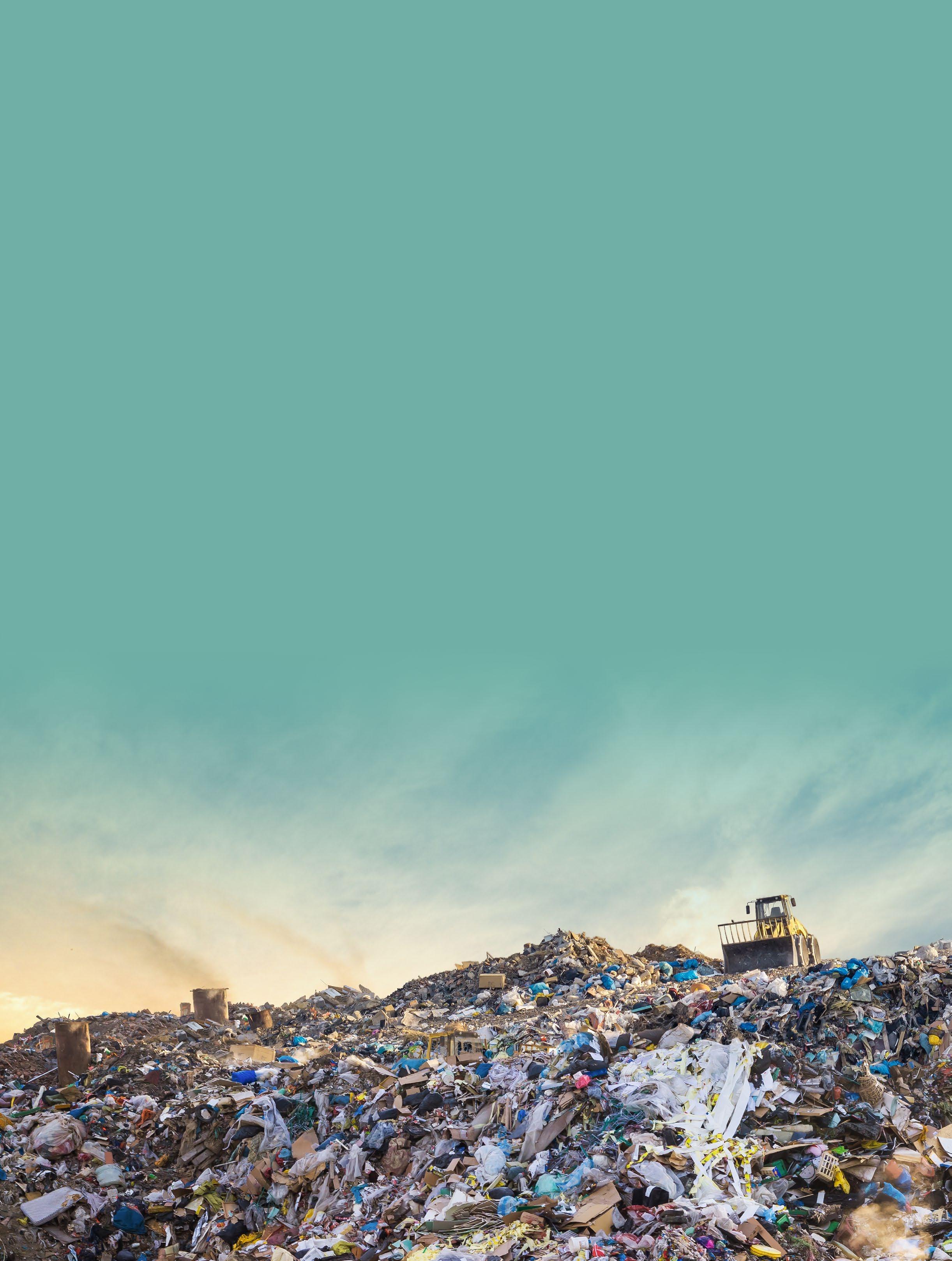
JANUARY 2023 / ISSUE 164 / GRIDPHILLY.COM
SUSTAINABLE
TOWARD A
PHILADELPHIA
ISSUE
Trash boats skim the Schuylkill Eastwick neighbors fight illegal dumping
WASTE
PAGE 14
The City has betrayed the public trust in recycling. Will they try to regain it?

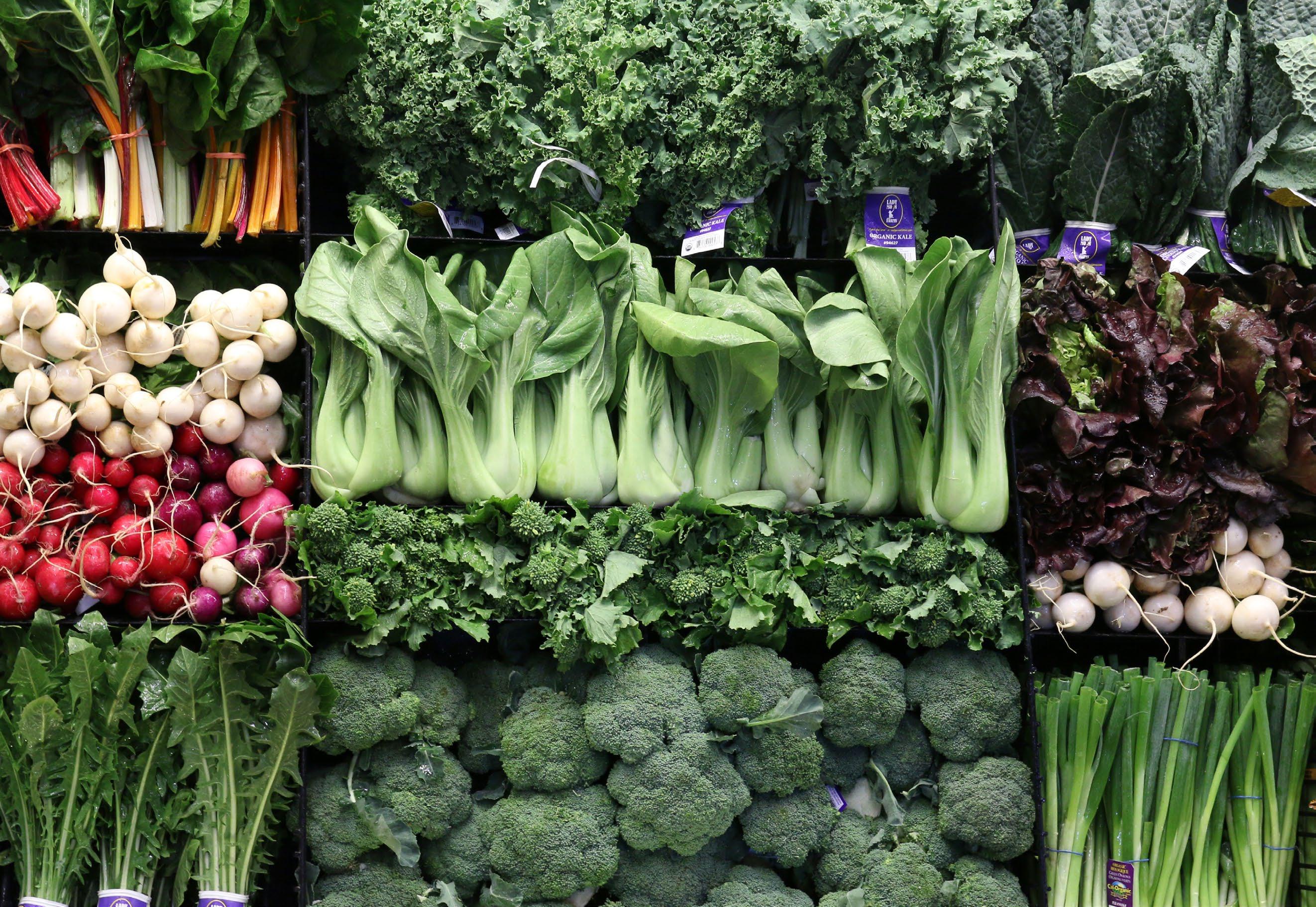
Kimberton Whole Foods is your one-stop shop for organic produce, raw dairy, local meats and cheeses, specialty items, baked goods, supplements, body care and more. COLLEGEVILLE | DOUGLASSVILLE | DOWNINGTOWN KIMBERTON | MALVERN | OTTSVILLE kimbertonwholefoods.com ORGANIC LOCAL FAMILY–OWNED NOW OPEN AT THE KNITTING MILLS IN WYOMISSING, BERKS COUNTY 810 KNITTING MILLS WAY | WYOMISSING, PA 19610
JANUARY 2023 GRIDPHILLY.COM 1 PLAN YOUR TRIP AT ISEPTAPHILLY.COM
publisher Alex Mulcahy
director of operations Nic Esposito associate editor & distribution Timothy Mulcahy tim@gridphilly.com copy editor Sophia D. Merow art director Michael Wohlberg writers Bernard Brown Constance Garcia-Barrio Lindsay Hargrave Bryan Satalino Ben Seal Samantha Wittchen photographers Chris Baker Evens Troy Bynum illustrators Bryan Satalino published by Red Flag Media 1032 Arch Street, 3rd Floor Philadelphia, PA 19107 215.625.9850
GRIDPHILLY.COM
Wasted Time
Whether it ’ s the shame of encountering trash dumped in your neighborhood, the despair of seeing a littered landscape or the outrage of witnessing recyclables and trash being dumped into the same truck, everyone who lives in Philadelphia eventually feels the psychological toll of mishandled waste. It makes all of us feel helpless, and then, the emotion on the other side of that coin: anger.
The City of Philadelphia has never gotten recycling right, despite having a recycling director in 1985, Maurice Sampson, who had a clear idea of how the nascent program should work, as you can read about in our story about glass recycling on page 28. Almost 40 years later, Mayor Kenney’s Department of Streets, led by Carlton Williams, has allowed recycling to hit what one only hopes is rock bottom.
The recycling department, such as it is, has been chronically understaffed and underfunded. For years at a time, the City has gone without even having a recycling director, and they have never had more than two people in the department. Unsurprisingly, there is very little outreach and education around how to recycle.
For example, did you know that wet paper can’t be recycled? That means every time it rains on recycling night, all of our uncovered bins become a contaminated mess, and what could have been recycled turns into trash. One of the City’s best kept secrets is that they offer lids for their bins, but to get one, first you need to know they exist, and once you do, you have to go to one of the city’s six sanitation convenience centers.
You can get bins there, too; one bin per visit, but you can get up to two per year, provided you don’t mind making two trips. Oh, and call ahead to make sure they have them in stock. And don’t forget to bring your government-issued identification with you. We wouldn’t want these bins to fall into the wrong hands.
Given the byzantine nature of even acquiring a bin, is it any surprise that our recycling rate has sunk to 7% – 1% better than it was in 2007 when there were bi-weekly collections in John F. Street’s administration?
While there is every reason to point out our City government’s ineptitude and/or indifference, it’s important to recognize that — like other problems plaguing the city such as gun violence, poor educational outcomes and homelessness — this is part of a national and cultural problem.
Despite the fact that, according to a survey published in 2019, 94% of Americans support recycling, the United States does not have a federal recycling program. It desperately needs one. Otherwise, access will always be scattered — more in cities, less in rural areas — and the success of a program will depend on the competence and commitment from local government. And that can fluctuate from one administration to the next.
While we need national rules around how to recycle, we also need to address an even larger question: How will we wean ourselves off the single-use container? It’s absolutely bonkers how much stuff we manufacture and dispose of, one way or another. Imagine if, after using a drinking glass at home, you threw it in the recycling bin. It’s absurd. That’s not really any different than what we’re doing every day across the country on a massive scale.
Yes, we should have a robust recycling program, but that should be the last resort. What we really need is legislation that eliminates as much single use as possible while encouraging reuse in every facet of our lives.
alex mulcahy , Editor-in-Chief

NOTES
EDITOR’S
by alex mulcahy
ILLUSTRATED PORTRAIT BY JAMES
2 GRIDPHILLY.COM JANUARY 2023
BOYLE


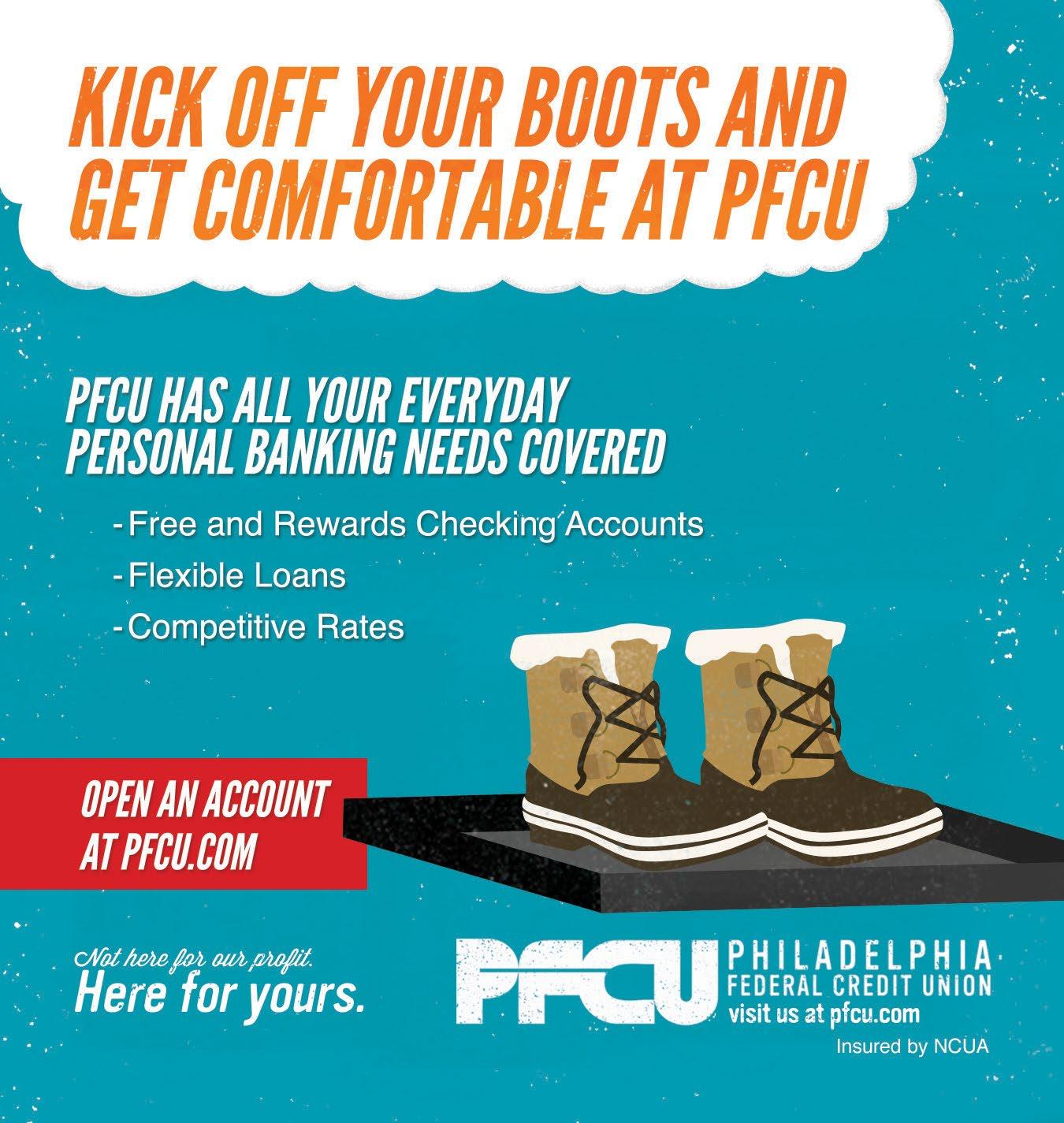

JANUARY 2023 GRIDPHILLY.COM 3 OPEN WEDNESDAY-SUNDAY 8am to 4pm Enjoy Fresh Air, Beautiful Scenery, and Great Wholesome Food with your friends and family! Regatta Room available for rental 1 Boathouse Row • 215-978-0900 cosmicfoods.com
Comfort Food
Brand born from grief creates meals that heal
After tragedy struck Rajus Korde’s family in 2018, he had two revelations. The first was that he wanted to find more meaning and purpose in his career. The second was that his family’s food was an expression of love in times of both joy and grief.
“Food played this role, particularly around joy and celebration, for the majority of our life to that point,” Korde explains. “And then it played a role of comfort and sitting around the table, holding grief.”
Korde’s parents were still living in Michigan and unable to have meals with their children and grandchildren to provide this comfort. So they began sending care packages of the Maharashtrian delicacies of their native India that conjured such a sense of home and love.
Despite having a growing family — Korde and his wife, Poorva, had a second child at the beginning of the pandemic — the impact of his parents’ meals motivated him to quit his job at the end of 2020 and launch Aaji’s, an Indian food brand inspired by the power of family.

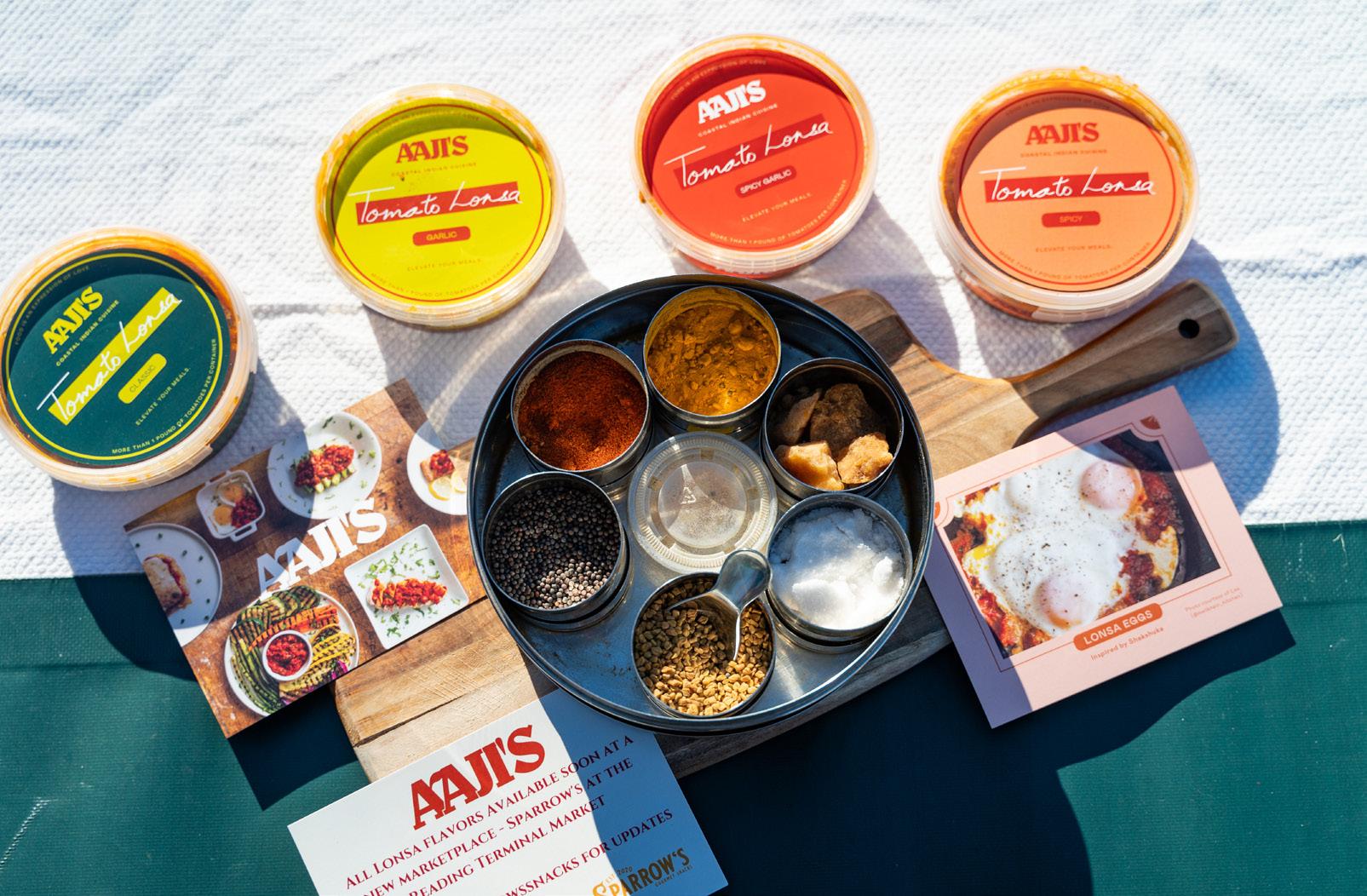
“Aaji” is the Marathi word for grandmother, so it was fitting that Korde’s mother and father joined the business, as did his wife, after his parents moved to Philly. They started off slowly, offering a variety of recipes as a “neighborhood taste test” to their Fairmount neighbors, delivering food three times a week with three different dishes in each package of food. Having a background in data, Rajus would ask each neighbor to fill out a survey. Since this was the height of the pandemic and everyone was home, it was, as Korde describes, “a little bit of this perfect storm to actually get that feedback.”
“We said, ‘Okay, don’t sugarcoat your feedback,’” Korde says with a laugh.
What they realized over the course of six weeks was that people liked their food. But they also knew that they didn’t want to start a restaurant. So they decided to start selling packaged food at farmers markets organized by The Food Trust and Farm to City. Korde praises the Philadelphia region and these organizations for cultivating such a rich and welcoming farmers market sector, which really allowed their business to grow.
Watching how their food was received at these markets was also a great joy. The tomato lonsa is the brand’s signature dish and is described on their website as “flavorful tomato-based topping or base ingredient that celebrates sweet, tart, spicy and umami tastes all in one.” Although there are
traditional ways lonsa is eaten in Mumbai, Korde gets a kick out of seeing his Western customers pair it with eggs and toast, and he thinks that if such nonstandard pairings expose people to food from his region of India, that’s positive.
“I think a macro trend that’s helping is this regionalization of cuisine and the appreciation for it in the U.S.,” he says. “So it’s not like Mexican food, it’s Oaxacan food. And it’s not Chinese food, but it’s Sichuan food.”
To prepare and package these meals, the Aaji’s team worked out of the Enterprise Center’s Center for Culinary Enterprises in West Philly. It was there that they met Candy Bermea-Hasan from Weavers Way Co-op, who sampled their food and knew she had to bring Aaji’s to Weavers Way in Ambler and Chestnut Hill.
“Getting in Weavers Way really paved the way for other retailers and boutique shops because I think Weavers Way has such a reputation and it validated our potential in retail,” Korde explains.
Now, Aaji’s brand foods can be found in markets such as Riverwards in Kensington and will soon be coming to the Weavers Way in Mount Airy, too. It’s not lost on Korde that a brand born out of grief in a city like Philadelphia, where there is so much trauma, can add a bit of healing at least for one meal. And for that Korde is grateful.
“I’ve worked in different industries, and the camaraderie and support of the food community in Philly is something that’s very special to us.” ◆
4 GRIDPHILLY.COM JANUARY 2023 PHOTOGRAPH BY CHRIS BAKER EVENS GRIDPHILLY.COM JANUARY 2023
sponsored content
Aaji’s brings a range of regional Indian dishes to Philadelphia.
Above: Vijoo Korde is the mother of founder Rajus and an actual “aaji” (grandmother).
























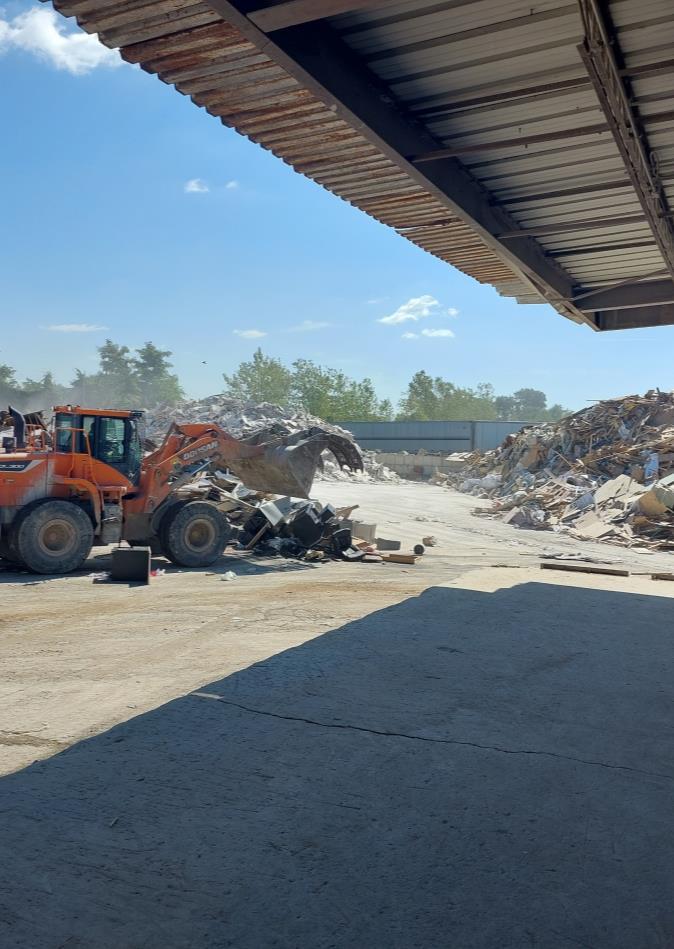


JANUARY 2023 GRIDPHILLY.COM 5 Make space in your home this New Year. Recycle your clothes AND electronics right from your doorstep with Retrievr. To schedule your pickup and learn what items we accept, head to retrievr.com/greater-philly.
The Buck Stops Here
Despite overpopulation, you can’t shoot any deer you like by bernard brown
Iwould be lying if I said I’d never snuck in anywhere I wasn’t supposed to.
I have gone herping (recreationally searching for reptiles and amphibians) all over Philadelphia, and more than once I have taken a look at a “No Trespassing” sign, glanced over my shoulder to see if anyone was watching and pressed forward. I’d also be lying if I said that being where I wasn’t supposed to be wasn’t part of the
fun. It gets the heart pumping and the adrenaline flowing in a way that setting foot on an official, blazed trail does not.
The same thrill of trespassing is probably felt by those illegally hunting deer in Philadelphia.
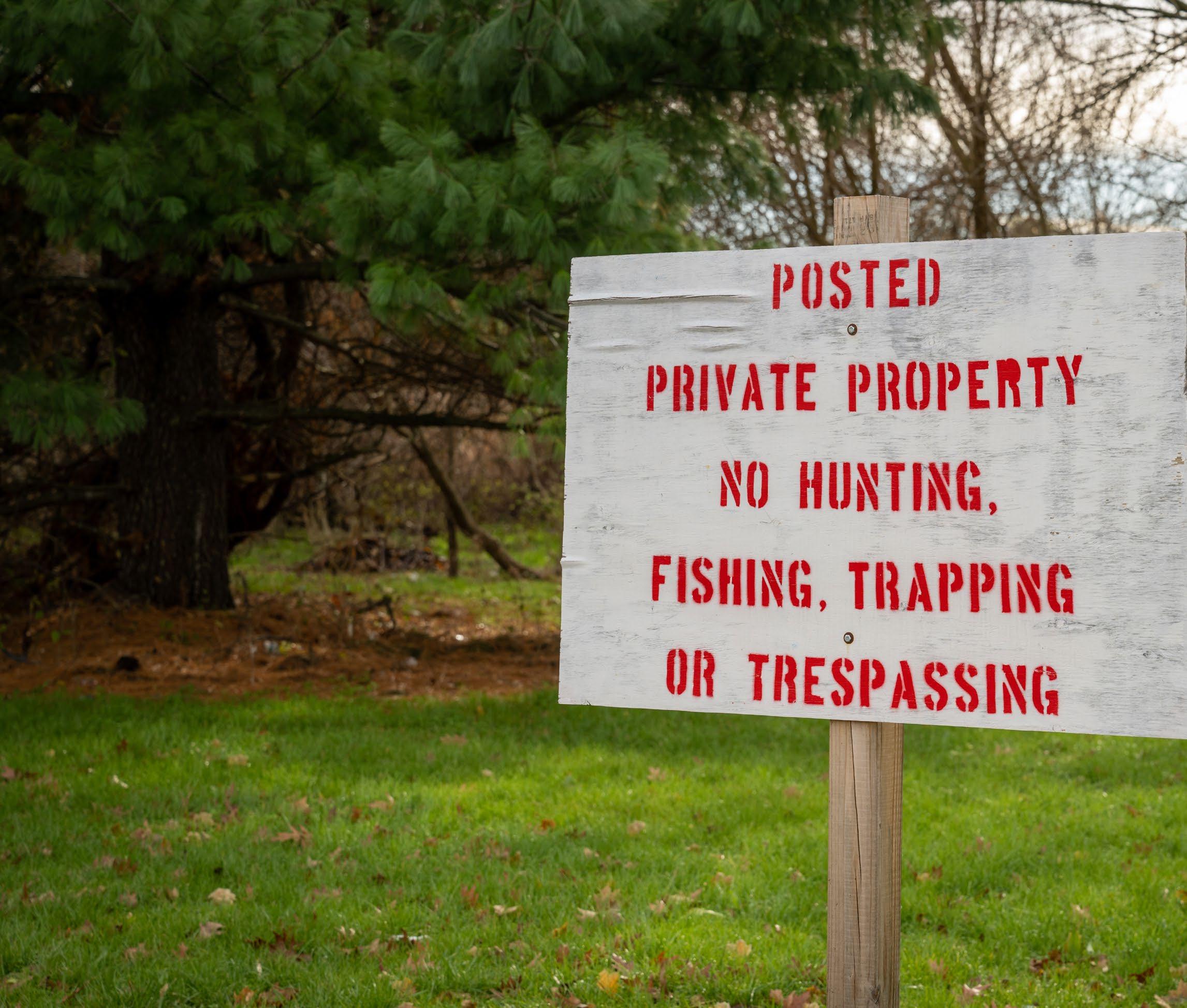
White-tailed deer flourish where woods mix with more open terrain like meadows, marshes and landscaped gardens — basically what you find in and around any Philly
park or vacant greenspace.
Philadelphia hosts densities of deer so high that they prevent forest regeneration, eating the next generation of trees before it can reach the canopy. Deer populations have rebounded since they were nearly wiped out at the end of the 19th century, but their nonhuman predators such as wolves and mountain lions have not. Trespassing hunters could argue that they are doing the
6 GRIDPHILLY.COM JANUARY 2023 urban naturalist
PHOTO BY TROY BYNUM
environment a favor by killing deer.
In a crowded city, however, the risks of amateur hunting might still outweigh the benefits. Humans have been hunting whitetails in what is now Philadelphia since the last ice age, but today, with about 12,000 people packed in per square mile, it takes professionals to safely kill deer without endangering humans, and to do so quickly enough to avoid any wounded animals staggering into traffic or a neighbor’s garden. That’s why Philadelphia Parks & Recreation hires teams of USDA sharpshooters to cull deer in an effort to reduce their impact on the forest, removing around 300 every year.
There are rare exceptions where amateurs can hunt. At the John Heinz National Wildlife Refuge at Tinicum and at Benjamin Rush State Park, mentored hunts offer new bow hunters the opportunity to kill deer. And although a few hunters get permission to hunt on larger parcels of private land, most Philly hunters looking to bag deer legally have to head out of town.

That hasn’t stopped some from trying to hunt where they shouldn’t.
When he set off on his daily walk, Eastwick Friends & Neighbors Coalition president Earl Wilson wasn’t expecting to find a couple hunters gutting a deer. Near the intersection of Mario Lanza Boulevard and Crane Street he spotted the two men. “At least one had a bloody hand, and apparently they had just killed the deer and were field dressing it right there. All I could say to myself was, ‘Don’t say anything, look forward and keep walking.’” (A first step after killing a deer is to “field dress” it by cutting out its entrails.)
Anyone walking or driving through Eastwick can’t miss the large white signs posted on the vacant properties that say in red stenciled letters, “POSTED, PRIVATE PROPERTY, NO HUNTING, FISHING, TRAPPING OR TRESPASSING.”
It was those signs that prompted me to ask Wilson, whom I was interviewing for an article on illegal dumping, about illicit hunting in Eastwick at the end of our conversation.
It’s a question I’ve gotten into the habit of asking whenever I talk with people who steward Philadelphia greenspaces, whether the spaces are public parks or private land. Whenever I ask, I hear stories.
In Cobbs Creek, a neighbor left an angry
note at a makeshift hunting blind he found in the woods. In Mount Moriah Cemetery visitors on a nature walk spotted a man carrying a hunting bow. In Morris Park a hunter had set up a deer stand — an elevated platform that hunters erect to get a better vantage point for hunting — and game cameras to help him track the behavior of the whitetails he was targeting. According to Pennsylvania Game Commission spokesperson Travis Lau, there were two deer illegally killed in Philadelphia in 2021, and none in the three years before that.
Brad Gates, a local wildlife manager, pointed out that since bowhunting relies on very close shots with a relatively slow projectile, it is unlikely to pose much of a practical threat to anyone except the deer being targeted. Also, someone can be obeying state game laws while trespassing, so people call the police in addition to the Game Commission. “There are people who cheat on the laws on anything, and trespassing is one of them,” says Gates.
That brings us back to sneaking in. I could always argue that tromping about and taking pictures of snakes or frogs didn’t hurt anyone, which is what I imagine a hunter slipping into Morris Park or vacant land in Eastwick says, or, for that matter, swimmers jumping in at illegal swimming holes like Devil’s Pool.
But that doesn’t make it feel like any less of an invasion to the neighbors. It became clear to me as I reported the illegal dumping article how helpless people felt when outsiders violated their neighborhoods, and how damaging that feeling is. Outsiders didn’t care that they were doing things the locals clearly didn’t want done. Tracking down and running off dumpers, even if it was a small action in the face of a huge problem, restored local residents’ agency, their sense that they were in charge of their own spaces.
Knowing this certainly takes the fun out of sneaking in, as it should. ◆
If you spot someone hunting in Philadelphia where they should not be, call the Game Commission’s Operation Game Thief hotline at 888-742-8001. The Game Commission enforces state laws governing hunting, including seasons when hunting is allowed, safety zones and what animals are legal to hunt.
JANUARY 2023 GRIDPHILLY.COM 7
Signs to deter illegal hunting aren’t just found in the woods of Philadelphia, but also on vacant lots like this one in Eastwick.
There are people who cheat on the laws on anything, and trespassing is one of them.”
— brad gates, local wildlife manager
Coming of Age
A Philadelphia woman supports girls to grow into confident adults by constance garcia-barrio
In 2011, an enraged 12-year-old stormed into the office at a charter school and marched up to Edwena Lanier, the office manager at the time and founder and leader of Girls Talk, a forum for girls aged 10 to 19.
“She was furious because she’d gotten a D on an English paper,” says Lanier, 38, who now works in human resources at a West Philly charter school. “At first, she said she wouldn’t go back to that class or talk with the teacher. I knew from the girl’s participation in Girls Talk that she struggled with adult authority.” That knowledge helped Lanier find a thoughtful solution.
“I asked the girl what she liked doing in summer, then I pointed out that if she had to repeat the class and attend summer school, it would put a crimp in those plans,” Lanier says. “In the end, she returned to the classroom, retrieved things she’d thrown around the room and apologized to the teacher. Later, in a conference with the teacher, she explained how hard the course was for her. The teacher began giving her extra help, and she passed the class with a B.” Incidents that could derail a young person can become key life lessons with good advice, Lanier says. “Girls Talk encourages that outcome.”
The program is free. Friends, families, community partners and Lanier herself fund activities, she says.
A South Philly native, Lanier saw firsthand the results of unwise choices.
“I grew up seeing the consequences of my parents’ poor decisions,” she said. “I want to help girls avoid those pitfalls.”
On the other hand, Lanier saw the difference one person could make for neighborhood youth.
“My grandmother didn’t have much money, but if she knew a child’s parents would be home late, she would call that child in to eat with us,” Lanier says of her grandmother, who moved from Richmond,
Virginia, to Philly as a teenager. “Sometimes, she seemed to feed the whole block.”
Lanier also gained inspiration from Pamela Price, her teacher in sixth through eighth grades.
“A small group of us would meet with Ms. Price in Clark Park,” Lanier says. “She would bring snacks and talk about what I later realized were life skills. A bunch of us caught up with her recently and gave her a festive dinner to show how much she’d meant to us.”
Like Price, Lanier keeps Girls Talk groups small, with 10-week sessions in the fall and spring, each with a dozen girls. She divides the gatherings into one group for girls aged 10 to 14 and another for participants aged 15 to 19. Besides other group members, each girl has a buddy, a special confidante.
Like many girls, Amirah Branch, 13, a member since age 9, learned about the program through word of mouth in her South Philly neighborhood.
“It’s made a huge difference,” Branch says. “I was shy at first, but we had icebreakers like trivia. I feel like I have a bond and a trust with the other girls.”
Branch’s mother, Ashley Williams, 33, is grateful for her daughter’s participation.
“Mrs. Lanier is like a big sister, a parent ally,” Williams says. “Amirah doesn’t tell me everything, but she has Mrs. Lanier.”
Lanier emphasizes self-esteem, selfacceptance, hygiene and assertiveness.
“I want girls to know how to express themselves with style and grace, especially when they’re hurt or angry,” she says. “It prepares you for professional life and leadership. I want to equip them to find their way forward when their plan A falls through.”
Lanier encourages the girls to develop affirmations as guideposts.
“Sometimes they surprise me with their wisdom,” she says. “One girl came up with: ‘You are stronger than your deepest fear.’”
Lanier also urges participants to look at
the media through a critical lens.
“The media depict young women with the supposedly perfect shape, the perfect hair, and girls often feel they fall short,” Lanier says. “I’ll ask them, ‘What do you like about yourself?’ They realize that their strengths and vulnerabilities make them unique.”
Dread is a frequent topic.
“Many have childhoods filled with fear due to gun violence,” says Lanier, the mother of two daughters, Aleemah, 12, and Aniyah, 17. Lanier, a social work major at West Chester University who will graduate in 2023, uses her knowledge of community resources. “I refer girls for grief counseling or therapy, if necessary.”
Older girls often discuss college, careers and health, according to Lanier.
“Some girls have become sexually active or are considering it,” she says. “I offer guidance.”
During winter break, Lanier rents a suite at an airport hotel for a giant slumber-andpool party.
“It helps reinforce principles and aids in bonding,” Lanier says.
Sometimes, long-lasting connections develop.
“I joined at age 12 because Mrs. Lanier had a positive attitude,” says Chynna Morris. “I’m 23 now, and we’ve stayed in touch,” says Morris, who assists people with disabilities. “I was 17 and in high school when my mother passed. Mrs. Lanier was a great help then.”
Lanier has also reached youth through a book she co-wrote with Aleemah during the pandemic.
“I was 7 or 8 when a girl began bullying me at school,” says Aleemah. “She would say things that made me feel bad about myself. I felt like the situation could turn physical, so I told my mom.” Lanier and Aleemah met with the bully and her mother. “I wasn’t sure the girl would change, but when I saw her stressing over schoolwork, I started helping her, giving her tips about reading. It turned out, she was a nice person. Now we’re on the same basketball team in middle school.”
“Let’s Help the Bully,” available on Barnes and Noble’s website for $20, mirrors bullying experiences of both Aleemah and Lanier. “I liked writing with my mother,” Aleemah says, “and we had lots of people at the launch party.”
Lanier’s accomplishments won her West Chester University’s Charlotte Newcombe Scholarship. “Edwena’s commitment to
8 GRIDPHILLY.COM JANUARY 2023
city healing
PHOTO COURTESY OF EDWENA LANIER AND GIRLS TALK
advances in equity and inclusion is … clear in her more than ten years working in the education sector and serving as a mentor through … Girls Talk,” judges for the scholarship committee wrote.

In the future, Lanier hopes to open Girls Talk centers. ◆
To learn more about Girls Talk, follow @letshelpthebully2021 on Instagram or email EL963000@wcupa.edu
JANUARY 2023 GRIDPHILLY.COM 9
I want girls to know how to express themselves with style and grace, especially when they’re hurt or angry.”
edwena lanier, founder of Girls Talk
Edwena Lanier uses the lessons she learned as a teenager to serve as a role model for young girls facing difficult upbringings.
Skimming Skiffs
The Water Department’s nautical efforts to keep plastic out of the ocean by bernard brown
Three philadelphia water Department (PWD) trash skimming boats ply the waters of the Delaware and Schuylkill rivers, floating goalkeepers trying to prevent plastic debris from reaching the ocean.

The current circulating around the North Atlantic leaves a quiet section of ocean in the middle called a gyre. A patch of plastic garbage hundreds of miles across floats in the North Atlantic Gyre, and more than a few plastic bottles from the streets of Philadel-
phia rise and fall with the waves. Gradually they break down into smaller pieces under the force of waves and solar radiation. The plastic bits then sink lower in the water column, eventually landing in the stomachs of sea creatures or the sediments at the bottom.
Until a ban on single-use containers is enacted, there will be nothing new about the best ways to keep Philly plastic out of the ocean: reduce, reuse, recycle. This summer the Academy of Natural Sciences of Drexel University sponsored 10 works of
art to encourage Philadelphians to consume less plastic by using reusable water bottles instead of buying bottled water. Silas McDonough’s Waterline exhibit, viewable at the academy through January 8, portrays three large plastic jugs, themselves made out of recycled plastic.
Sadly, bottled water and other single-use plastics are still available for sale in Philadelphia. And some of that single-use plastic lands on the sidewalks and streets, where it is eventually washed into the curb-level openings of storm sewers. There the plastic enters the domain of PWD.
Every day, PWD crews clean grit, leaves, sticks and trash out of the storm sewer inlets. So far in 2022 they have pulled about 5,000 tons of debris, all of which can clog inlets, forcing stormwater into the streets
10 GRIDPHILLY.COM JANUARY 2023 PHOTOS COURTESY OF PWD water
The Philadelphia Water Department has a marine services team that cleans our rivers.
and exacerbating neighborhood flooding. This makes removing the debris a disaster preparedness measure, but it also keeps the plastics from escaping into our waterways.
For the bottles (and half-deflated basketballs, baby doll heads and other floating plastic) that make it into the Delaware and Schuylkill rivers, PWD’s trash-skimming boats take over the effort, removing 10 to 20 tons per year.
Plastic washing into Philly waterways is a big problem, says Maria Horowitz, an environmental engineer with PWD. “Unfortunately we could always do a better job of dealing with it. Skimming boats are the last line of defense.”
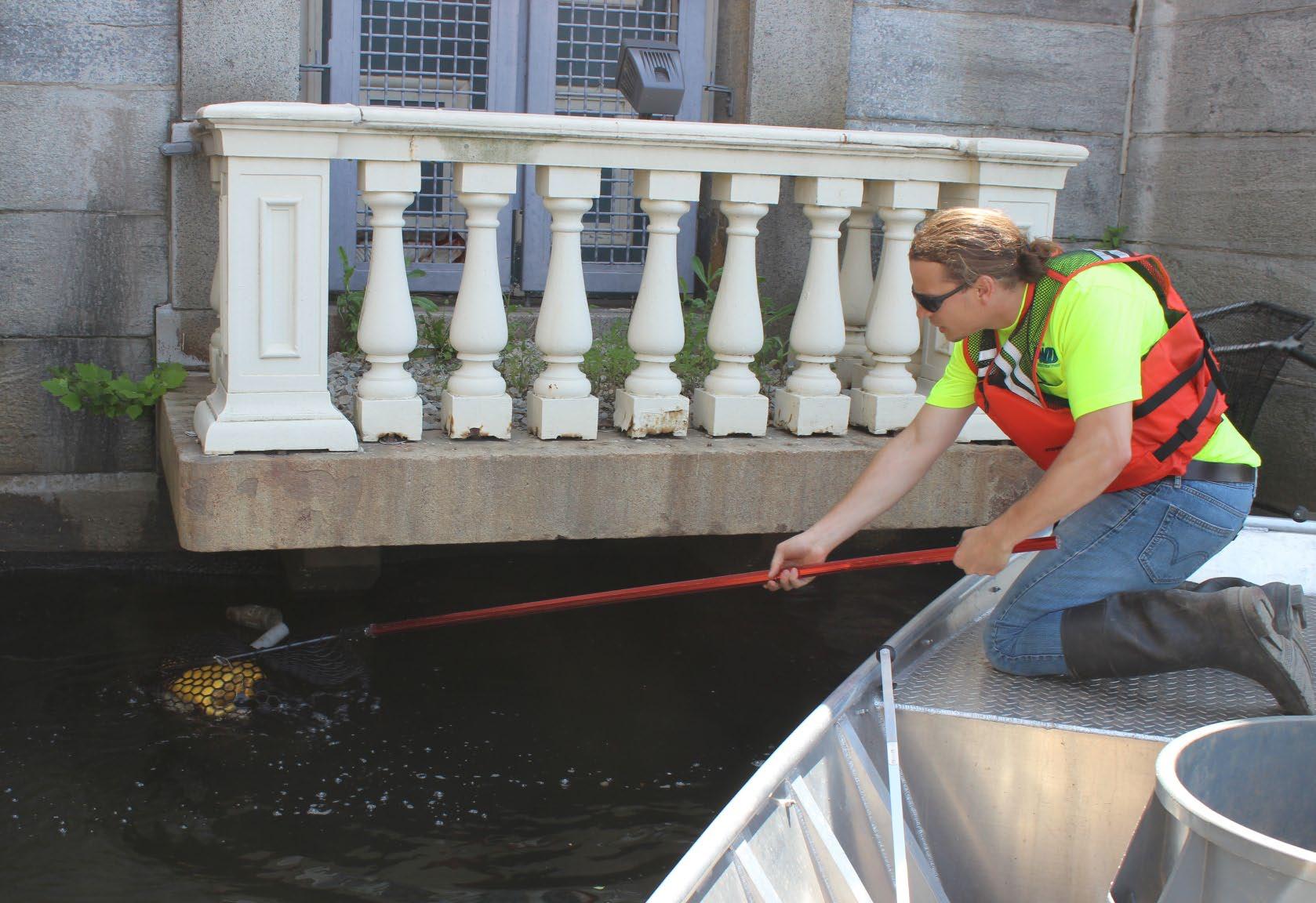
PWD depends upon a 20-foot boat, a 25foot landing craft with a drawbridge that facilitates loading debris and unloading equipment and the 38-foot R. E. Roy trash skimmer.
The R. E. Roy, operated by a contractor, “has a suction functionality and a clam shell. It can go and grab things,” says Horowitz. As
a larger boat, it sticks to the center channels of the Delaware and the Schuylkill.
The smaller boats bring cleanup efforts closer to the banks. “You can get into places like the dam at the Art Museum, picking up trash you might not be able to reach otherwise,” says Brian Rademaekers, a PWD spokesperson. “It’s hard work, but rewarding to get litter and trash from those hardto-reach areas.”
For more than 20 years PWD senior scientist Lance Butler has captained department vessels for trash cleanup efforts as well as for research, infrastructure inspection and public outreach. Although Philadelphians still use a lot of single-use plastic, Butler believes that less of it has been making it into the rivers.
“One of the misconceptions [of Philly river water] is that it’s filthy. Yes there are debris and floatables, but compared to 20 to 25 years ago the rivers are much cleaner. It was hard to navigate in the late ’90s or 2000s on a good day,” Butler says. Back then he often ran into logs, plastic barrels or “marine debris” such as floating chunks of marinas. “I have recollections of … large trash islands coming down the Delaware River or in some instances in the tidal Schuylkill, but I do not see that anymore.”
Even as the overall volume of trash in the rivers has decreased, one thing has remained the same. Most of that volume is plastic, Butler says. “It’s something that not just the City of Philadelphia but the nation as a whole has to get a handle on.” ◆
JANUARY 2023 GRIDPHILLY.COM 11
It’s hard work, but rewarding to get litter and trash from those hard-to-reach areas.”
brian rademaekers, Water Department spokesperson
PWD Environmental Scientist Rick Anthes takes a break from his normal duties to manually skim plastics out of the Schuylkill River in front of the Water Works near Kelly Drive.
Over The Top
In a city with a long history of woeful recycling rates, Dyvert is trying to make a difference.
The Philadelphia-based company aims to boost the circular economy by improving the messaging found around waste, recycling and compost bins to make them more effective and efficient. Its products offer public facilities the ability to display commonly used items in an enclosed transparent lid that sits atop waste bins to clearly instruct people where to put their trash and recycling.
At a stadium, for example, water and beer bottles would be displayed around the opening to a recycling bin, while hot dogs, pretzels and paper waste would be shown in the lid to a trash can. By clearly demonstrating what goes where in a site-specific context, Dyvert’s products eliminate the guesswork that often flummoxes people — and the contamination that makes recycling less efficient.

For founder Ben Ditzler, this simple but effective messaging is an important tool to
improve the way Philadelphia and the rest of the world recycles.
“It comes down to what I’ve always felt about recycling and waste,” Ditzler says. “It’s really the front door to sustainability.”
With that in mind, the former civil engineer is hoping Dyvert can be a stepping stone toward broader improvements in Philadelphia’s approach to environmentalism. The city’s recycling rate has dwindled into the single digits since the pandemic and was already significantly behind many major cities before then. Confusion about what to recycle is part of the problem.
In a two-week study at the University of Pennsylvania, Ditzler says, results showed that contamination was nearly cut in half and recycling diversion rates increased significantly when using Dyvert lids, compared with the normal text-and-image messaging that was previously used near waste bins. By cleaning up recycling from the consumer side, Ditzler wants to help fix underwhelming rates and expand sustain-
able thinking at the same time.
“As people grasp that there’s a small step they can take, they start thinking about bigger steps they can take individually but also collectively as a society,” Ditzler says.
Ditzler’s interest in recycling goes back a long way. He grew up visiting the recycling center in his hometown of Ridgefield, Connecticut, and he helped his neighbors acquire recycling bins after he bought a house in Philadelphia in 2006 and realized that he was the only one on his block recycling. After getting into the sustainability community around that same time, he worked as a recycling consultant and on waste composition studies.
“I actually liked digging through the trash,” he says. “Who would’ve guessed?”
In 2014, he was working on a commercial recycling toolkit for the city when the idea for an improved messaging system struck him while riding the El. He acquired the patents for Dyvert, launched in 2019, and is now beginning to roll the product out to Philadelphia locations, including architecture firm KieranTimberlake and education nonprofit Mighty Writers. Xavier University of Louisiana is about to put 60 of Dyvert’s units on its campus, picking up on Ditzler’s pitch to simplify the work of facility managers.
“Everyone generally understands that recycling is good, but they get a little iffy when it comes to what to recycle,” says Angeliqué Israel, literacy leader in Mighty Writers’ West Philadelphia location, who has used the Dyvert unit to teach the children in her afterschool program about recycling. Thinking more deeply about landfills and recycling centers has led her to find a recyclable option for the single-use cups children use every day across Mighty Writers’ 10 locations.
Dyvert can’t solve all of Philadelphia’s recycling or sustainability problems, but Ditzler wants it to be part of the solution.
“It can be difficult and daunting to think of the big picture,” Ditzler says. “If you can at least start thinking small, start thinking bottles and cans — and we know that’s just the tip of the iceberg — it really opens your eyes to what else is out there.”
12 GRIDPHILLY.COM JANUARY 2023
PHOTO COURTESY OF DYVERT
◆
recycling
Dyvert’s innovative lids boost recycling rates by ben seal
Dyvert’s clear plastic lids display what goes where.
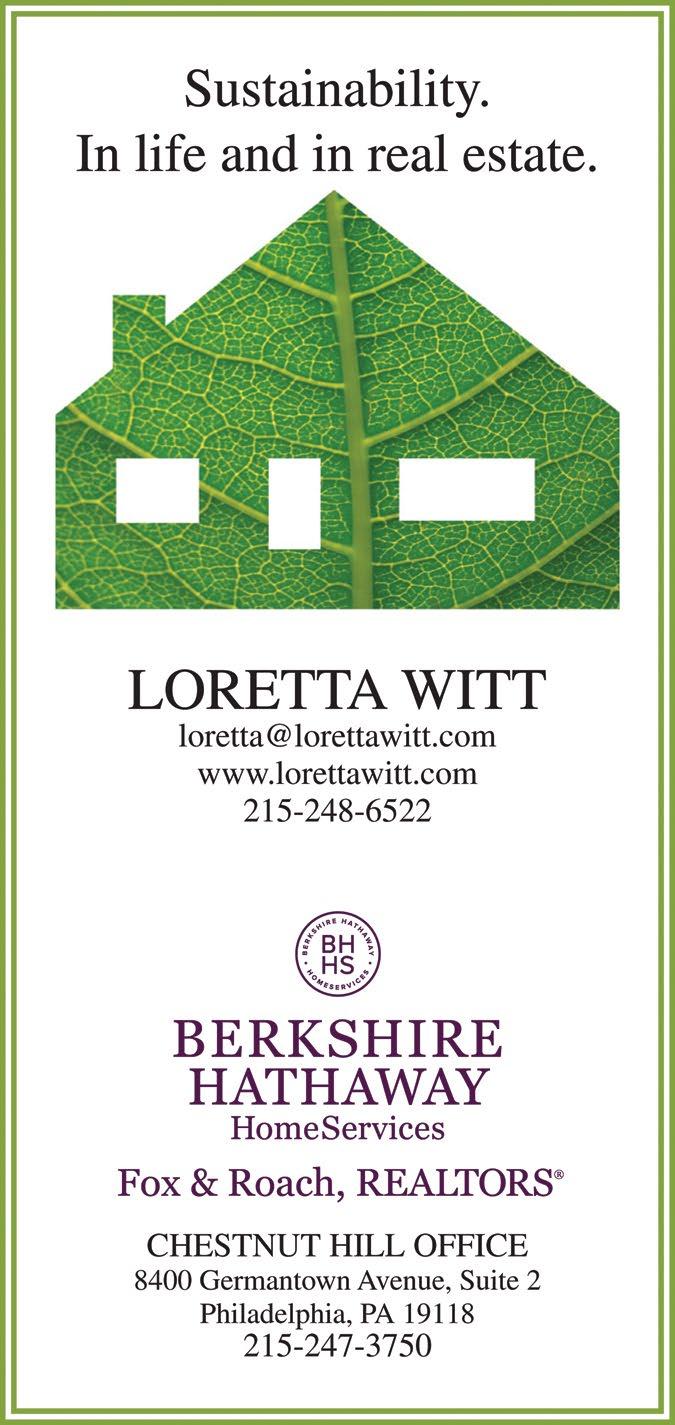




JANUARY 2023 GRIDPHILLY.COM 13 PRESCHOOL THROUGH GRADE 12 | KIMBERTON.ORG 610.933.3635 EDUCATION THAT MATTERS Offering a holistic, experiential and academically-rich approach to education that integrates the arts and the natural world every day. $25 FOR ANY BUSINESS THAT JOINS SBN NOW THROUGH MARCH 31, 2023 OFF FOR MORE INFO VISIT: WWW SBNPHILADELPHIA ORG MEMBERSHIP
SORT OUT
In july 2020, after spending several months of the pandemic wondering whether her trash and recycling would be picked up, Sarah Ausprich was frustrated. When it was collected, Ausprich, a resident of Philly’s East Passyunk neighborhood, watched sanitation crews repeatedly combine her trash and recycling in the same truck. Disillusioned by curbside collection, she decided she would hold onto her recycling and take it to one of the city’s six sanitation convenience centers every few weeks.
Her first trip went smoothly, and the center had two separate trucks on site for trash and recycling. On her second trip, though, she encountered only one truck — a trash
ITtruck. The worker staffing the center insisted that her recyclables were dirty and therefore trash, even though she had been storing them in her clean and dry basement. With no other option, she begrudgingly tossed her recyclables into the truck and left feeling dejected — and determined to make sure it didn’t happen again.
Thus began Ausprich’s journey to cobble together recycling alternatives that didn’t rely on the Streets Department or the blue bin. She takes her glass to Bottle Underground in the Bok Building. Aluminum cans go to a scrapyard in Northeast Philly. Rabbit Recycling takes her plastics, paper goes to a middle school near her sister’s house in Delaware County and she finds people to donate her cardboard boxes to through neighborhood Buy Nothing Facebook groups.
“I don’t recycle through the City at all anymore,” says Ausprich. “I don’t trust that
it won’t end up contaminated or mixed in with trash. It’s really disheartening.”
Ausprich isn’t alone in her sentiments. Other residents, like Fishtown’s Kate Zmich, have opted out of recycling through the City.
Zmich takes glass to Bottle Underground, and she uses Rabbit Recycling for many other recyclables. In addition to losing faith that the City would manage recycling properly, she was motivated by a desire to lighten the load for sanitation workers, whom she began to feel were not being adequately supported by the Streets Department during the pandemic.

14 GRIDPHILLY.COM JANUARY 2023
story by samantha wittchen photography by chris baker evens
How recycling lost its way in Philadelphia and what can be done to get it back on track
“It came from knowing recycling in Philly is a mess, and it came from the mismanagement of the workers, and knowing that leadership doesn’t prioritize it, and not wanting to burden the workers with these materials,” says Zmich.
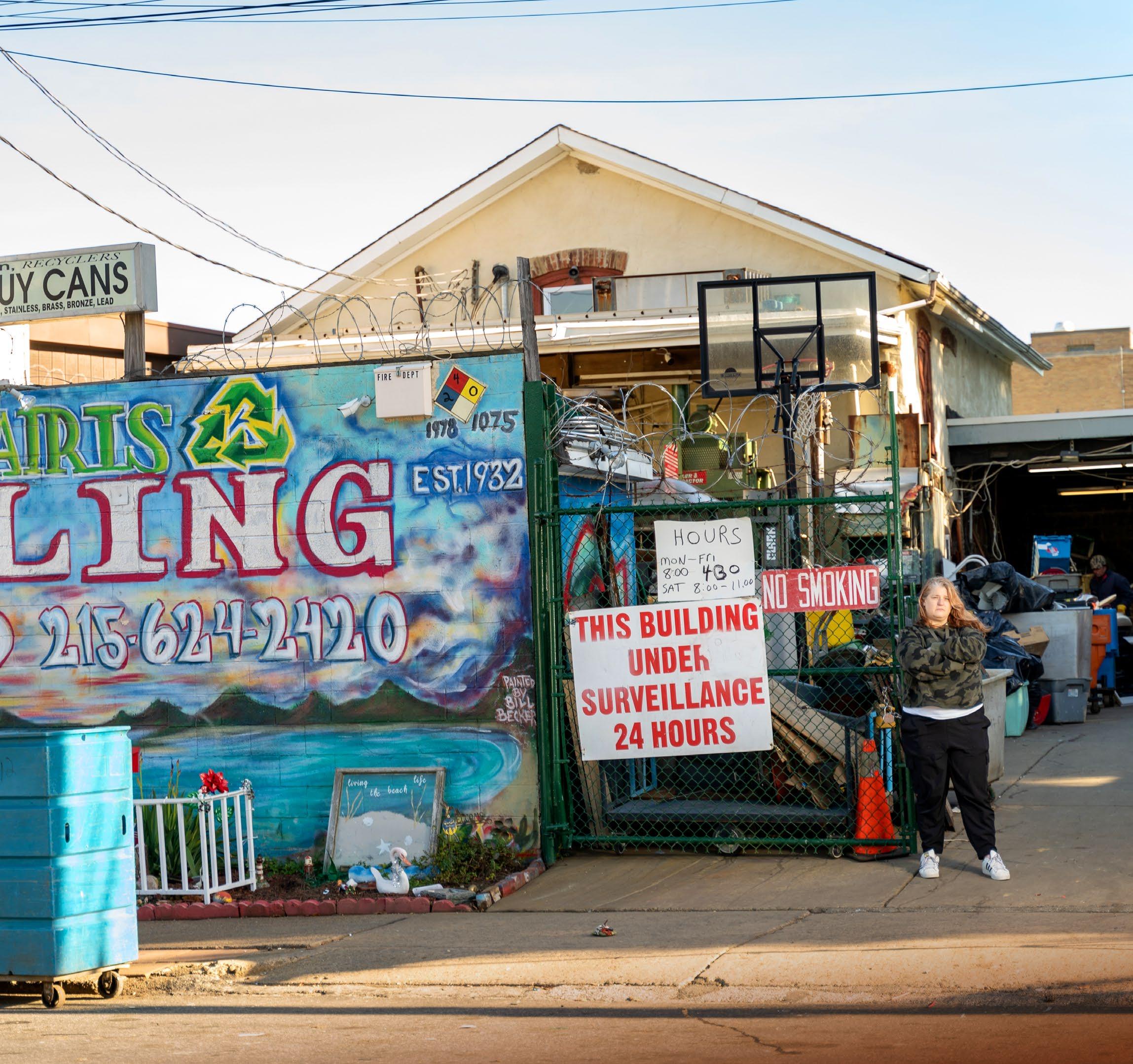
After making substantial gains in recycling during the Nutter administration, Philadelphia has backslid over the course of the Kenney administration to the point where recycling statistics are now almost to the level they were in 2007 under Mayor John Street — before the Nutter administration rolled out single-stream recycling and
sarah ausprich, Philadelphia resident and dedicated recycler
boosted the city’s recycling rate from 7% to a high of 21% in 2015. Once again, Philadelphia’s recycling rate is 8%: almost a decade’s worth of progress — erased.
“The Streets Department is reverting
back to a waste collection agency, and it’s putting everything in the trash,” says Maurice Sampson, Eastern Pennsylvania director for Clean Water Action and the City’s first recycling coordinator from 1985 to 1987. “We have a department whose mentality is disposal and not recovery.”
Grid asked what the plan is to increase the recycling rate to recapture the losses of the last several years, but a Streets Department spokesperson had not yet responded at press time.
How did Philadelphia get here after almost a decade of steady progress on recy-
JANUARY 2023 GRIDPHILLY.COM 15
I don’t recycle through the City at all anymore.”
Sarah Auspich drives from her home in South Philadelphia to Holmesburg to drop off recycling.
cling and better waste management?
At the beginning of the Kenney administration, it looked like the City was poised to build upon the gains of the Nutter administration and propel Philadelphia to an ambitious goal of zero waste by 2035. Kenney established the Zero Waste and Litter Cabinet (ZWLC), led by director Nic Esposito out of the Managing Director’s Office. (Esposito is director of operations at Grid, and cofounded Circular Philadelphia with the author.)
His office was to take a holistic approach to addressing thorny waste issues that require cross-government collaboration, like litter and illegal dumping.
Prior to the establishment of the ZWLC, recycling and waste concerns were largely within the purview of the Streets Department. (The City’s Recycling Office was subsumed into the department in 1998.) Since then, there have been extended periods of time when the recycling for Philadelphia, a city of 1.5 million people, has had a dedicated staff of one or two people.

Despite this, the Nutter administration made hefty gains in the city’s recycling rate, attributable to the rollout of single-stream recycling and the Recycling Rewards program, which incentivized residents to recycle. The Streets Department regularly shared recycling rates, and outreach and education was targeted to neighborhoods where rates were lower.
Under former Streets Commissioner David Perri, the Nutter administration began to approach waste management holistically to improve efficiency and promote alterna-
tives to disposal. The department started looking at the possibility of franchising commercial waste collection, like in New York City, to reduce the number of trucks crisscrossing the city daily to collect waste from businesses. It also began investigating how to eliminate dumpsters from city sidewalks and alleys, an act that would most likely boost waste reduction and recycling as businesses sought alternatives to throwing things away while making our streets cleaner and the air less foul.
After the ZWLC was created, the City supercharged its use of data to create the citywide litter index and focus scarce resources for anti-litter, cleaning and illegal dumping where they were needed most, like Kensington and Southwest Philadelphia. Perhaps even more importantly, the ZWLC set waste and litter reduction goals for the city and published regular reports to the public that showed the progress the city was making, backed up by data.
“To use data as an integral part of the actual operation with a mandate to engage the community in the process to listen and learn and act and build a citizen-institutional coalition could really go beyond what had been done with waste management in the city,” says Mike DiBerardinis, former managing director for Mayor Kenney. “To move from a reactive position to a proactive position was an important shift.”
Daniel Lawson, sustainability and quality control manager for Philadelphia Parks & Recreation at the time, also saw the value of using a data-driven approach to manage
waste within the City’s own operations.
“I saw the power of the data,” says Lawson. “Having someone on the ground to visit rec centers and do inventories on recycling and to generate diversion rates and contamination rates was my primary tool to bring together leaders in the department and show them why we need to continue to do this.”
But this push to create goals, use data and report progress didn’t appeal to everyone in government. Even though the Streets Department was the “anchor organization” for the ZWLC because of their role in carrying out the work needed to meet goals set by the cabinet, they weren’t completely on board.

“The idea was to give Streets a roadmap that they helped create that they would use for the journey,” says DiBerardinis. “They were very resistant.”
Still, it appeared as though the City was making real progress towards its zero waste goal, and then the Streets Department, under the leadership of current Streets Commissioner Carlton Williams, allowed the City’s recycling contract to expire, resulting in the incineration of half of the city’s recyclables for a period of six months beginning in October 2018.
When the pandemic hit, Mayor Kenney abolished the ZWLC due to “budgetary concerns,” and sanitation operations fell apart, partly due to high rates of sanitation worker absence due to COVID-19 and fear of getting sick. “During the pandemic, morale was [historically low]. Nobody wanted to come to work,” recalls Terrill Haigler, a former sanitation worker who rose to fame as “Ya
16 GRIDPHILLY.COM JANUARY 2023
Auspich can talk to a person at M. Dunn Recycling to confirm where her recycling is going.
Fav Trashman” during the pandemic due to his frank, daily dispatches on Instagram that let Philadelphians know what was happening with trash and recycling collection. “There was no clear-cut communication from Streets on what was going on.”
The Streets Department was unprepared for a high worker absence rate and the increase in residential trash and recycling due to Philadelphians being stuck at home. This resulted in trash and recycling going uncollected in some neighborhoods for weeks at a time during the summer of 2020. The Streets Department repeatedly
assured residents at the time that pickups were back to normal, and that trash and recycling were no longer being combined, but residents reported seeing trash and recycling being emptied into the same truck for two years after the pandemic began, according to reporting by Billy Penn. As a result, the Streets Department destroyed what little trust residents had left in their ability to manage materials properly after the recycling incineration fiasco of 2018.
“The last excuse I heard was that they are dumping recyclables and trash into the same trucks and then sorting the recycla-
bles at a proper facility,” says Kathryn Nalley, a Kensington resident. “Am I actually supposed to believe that? I already assumed that most of the stuff in my recycling bin wasn’t being recycled, so I certainly don’t think anything recyclable is actually being recycled after being mixed with garbage.”
“You can’t BS the public,” says Perri. “Eventually they’ll find out.”
With no ZWLC left to drive the City’s zero waste goals, communicate with residents and broker the intra-departmental collaboration needed to tackle the city’s litter and dumping issues, many of the responsibilities fell to a Streets Department with little interest in carrying on the work, no pressure from the mayor to do so and no credibility in the eyes of Philadelphians.
“Without the executive authority and the resources, you’re done,” explains DiBerardinis. “You can continue doing the dayto-day, but if you’re going to impact the big environmental issues of today and tomorrow in the city, you need the blessing of the executive and the commitment down the line from the commissioners to carry out this work.”
“One of the best things that Kenney did was set up the Zero Waste and Litter Cabinet, and the worst thing he did was dismantle it,” says Perri.
“Where we are is predictable,” says Sampson. “As long as the mayor wanted this, it happened. Once he didn’t, it didn’t happen.”
It’s not entirely clear why Mayor Kenney seems to have lost interest in ensuring Philadelphia makes it to that 2035 zero waste goal that his own administration set. But the current state of the waste industry may offer a clue.

Currently, almost all recycling in the United States is handled by the four largest waste companies, including Waste Management, who holds Philadelphia’s recycling contract. These companies all own and operate landfills, and the margins on tipping fees at landfills in the Northeast are much higher than the margins on recycling. To make it worth it for these companies to offer recycling services to cities, they must charge high prices for recycling to compete with the fees they receive for landfilling.
When recycling fees are as high as landfill tipping fees, it creates a disincentive for municipalities to bother with the extra work of separating their waste for recycling. One
JANUARY 2023 GRIDPHILLY.COM 17
One of the best things that [Mayor] Kenney did was set up the Zero Waste and Litter Cabinet, and the worst thing he did was dismantle it.”
david perri, former Streets Department commissioner
Former Streets Commissioner David Perri still has plenty of advice for how the City can improve its recycling and waste management operations.
Philly-area waste management professional with decades of experience in the industry that Grid spoke with for this article predicts that without state regulations that require counties to recycle, a lot of them would stop recycling altogether.
Waste Management’s landfill ownership also means that there’s little reason for them to care about whether recyclables that enter their facility ultimately end up recycled because they don’t have to pay extra to dispose of any materials that fail to find a market for recycling. In Philly, this means that anything that doesn’t get recycled ends up landfilled or incinerated, contributing to climate change and causing health and quality-of-life issues for the low-income communities of color located near these facilities in places like Chester, Delaware County — one of the places where Philadelphia’s trash goes.
The City could mitigate some of these disincentives through better waste and recycling contracting. Philly’s recycling contract expires at the end of June 2025. If the Streets Department was serious about finding alternatives to Waste Management to handle recycling — and possibly add composting — it would start the RFP process in the next six months, according to a Philly-area waste management professional who is familiar with how Philly’s recycling contracts work.
However, if it waits until six months before the contract expires as it has in the past, Waste Management will likely be the only bidder. This means they can set whatever conditions and price they want, and it will most likely cost the City more.
So where does Philadelphia go from here? To have any chance of moving towards a low-waste, circular economy that is so critical to the future of our city and planet, Philly must first get the basics right.
“I believe it’s not recycling that’s broken. Waste management is broken,” says Sampson. “We have mechanisms to make the waste management system work, but we don’t put them together.” Sampson suggests that the next mayor needs to recognize that the system is broken and needs to be fixed, and then he or she needs to install the right leadership to do it.
“We need to hire professionals and allow them to run the Streets Department,” insists Sampson.
With the way the Streets Department is
currently structured — being responsible for both streets engineering and sanitation — an outsized amount of the city’s quality-of-life issues, like picking up trash and recycling, cleaning litter and dumping, and filling potholes, fall on the department to manage. It’s too much for one department to handle, and the City’s most recent former sustainability director, Christine Knapp, believes that breaking the department into two parts that can focus separately on roadways, traffic and public right of ways and sanitation and solid waste makes more sense. It would allow each department to do a better job addressing these issues.
“If you have two separate departments, you’re more likely to have commissioners and staff with more specialized expertise,” says Knapp. Professionals, like Sampson advocates for, rarely have expertise in both streets and sanitation. While some Streets Department commissioners prior to Williams have been engineers, there’s still been a steep learning curve to make the entirety of the department function well.
Creating a separate sanitation department may also solve an issue that others have indicated: planning—which doesn’t really exist now within the Streets Department but could be incorporated into a new department— needs to have influence over operations.

“You can’t have a planning department without two things: they need to have money (or budgetary authority) and they need to have formal reporting authority from Streets,” says DiBerardinis.
Former Streets Commissioner Perri suggests that there also needs to be someone at the deputy mayor level in charge of cross-departmental waste-related issues, similar to the position of the former ZWLC director. Lawson also supports this solution.
“A very simple thing to do would be to reinstate the functions of the ZWLC. Those functions that existed have not been effectively picked up by another entity,” says Lawson. “That cabinet was getting some real work done and making some real progress. Reinstating that will elevate this waste diversion work as a priority.”
Then there are a host of improvements the City could make when it comes to how it collects waste and recycling. Both Perri and Sampson agree that to help curb illegal dumping, the City should bring back collection of bulk items, like refrigerators and couches, that are frequently found in
dumped piles of trash.
Haigler believes the City should explore automated collection in some neighborhoods, as it would reduce the toll that collecting trash takes on sanitation workers’ bodies. This could be combined with improving how the Streets Department routes trucks by employing GPS to make collection more efficient and able to adapt to changing route conditions.
“What I saw from the beginning was a lack of a systematic flow,” explains Haigler. “Sometimes in the middle of the day, they’d switch the route. Or you’d almost be done
18 GRIDPHILLY.COM JANUARY 2023
Terrill Haigler, aka “Ya Fav Trashman,” stands by a dumping site around the corner from his Germantown house.
and they’d be like, ‘You need to get nine more blocks.’”
And how to get Philadelphians’ trust back? Residents say that can only come from transparency and open communication.
Sabrina Murphy, another Fishtown resident, says the City could regain her trust with “a communication campaign to explain and address the rightful uncertainty with how they have been handling recyclable waste, what their plan is now and if they cannot commit to actually recycling our recyclables, what are the suggested alternatives to ensure citizens can still do the right
terrill haigler, former sanitation worker and City Council candidate
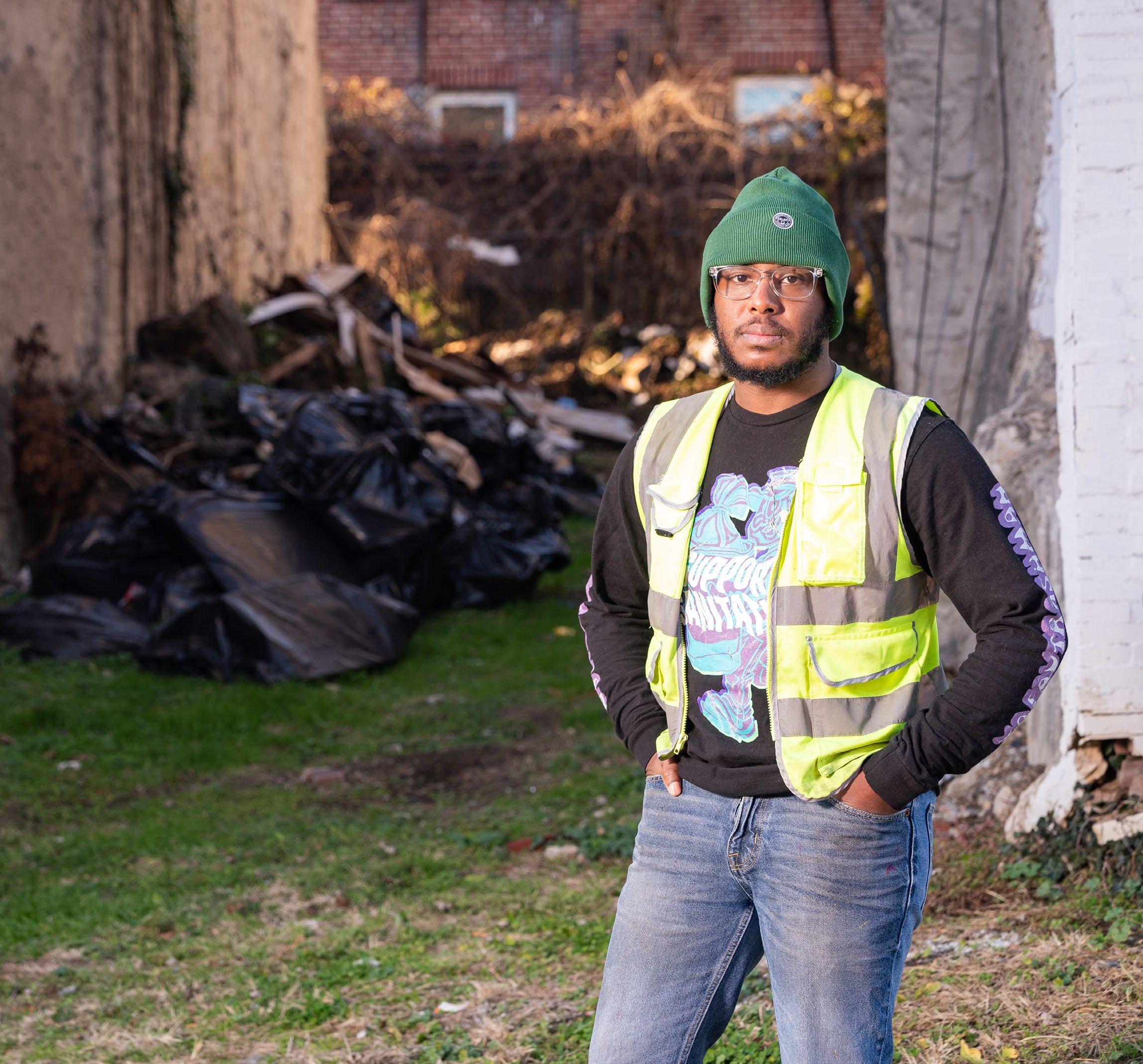
thing.” She adds, “I believe most people want to do the right thing but they want/ need direction and transparency.”
Haigler, who is running for City Council, agrees. “Repairing the trust has to come from transparency,” he says. “And then the
openness to hear suggestions and to shift and do things different from how you’ve always done them.”
Making these changes may seem like a tall order, but they are necessary if the next mayor wants to make serious progress on mitigating Philadelphia’s contributions to climate change, improving quality of life for all Philadelphians and winning back the trust of residents.
“When you think small, you necessarily act small,” says DiBerardinis. “ When you think big, you don’t necessarily win, but your chances go way up.” ◆
JANUARY 2023 GRIDPHILLY.COM 19
Repairing the trust has to come from transparency.”
A sign warning illegal dumpers of surveillance is hidden behind debris and dirt at the dead end of Lyons Place in Eastwick.
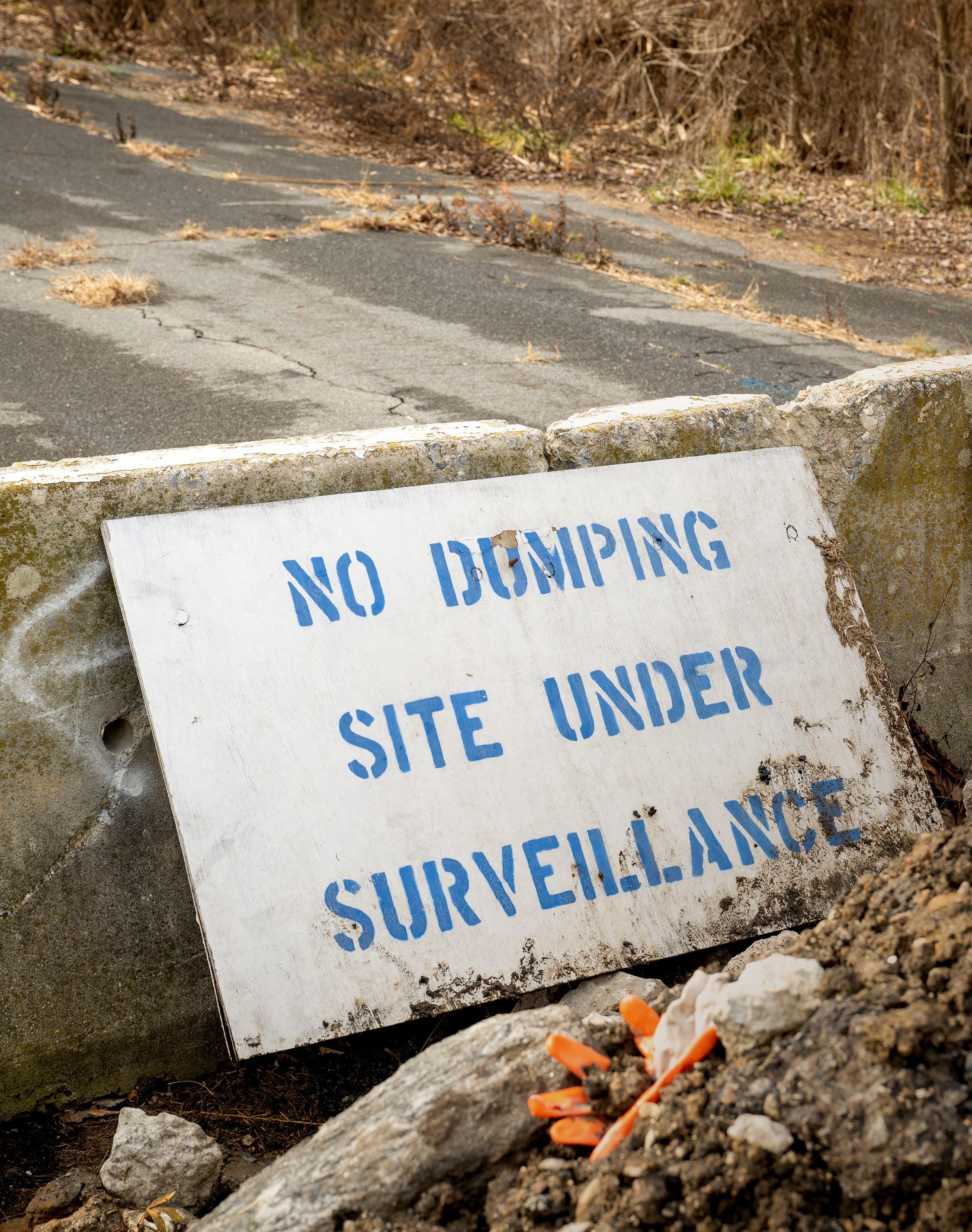
20 GRIDPHILLY.COM JANUARY 2023
DOWN IN THE DUMPS
The city’s illegal dumping problem persists despite decades of efforts to curb it

To the south of 86th Street in Southwest Philadelphia’s Eastwick neighborhood you can’t drive more than a few yards on the cross streets before you run into concrete barriers.
“We had them put up the barricades since they would pull back in the cul-de-sac and dump,” says Leonard Stewart, a longtime Eastwick resident and community activist, referring to the 135 meters of Gibson Street that extend beyond the barrier until the street dead-ends into vacant greenspace.
In 2018, responding to years of complaints from the residents who live on the residential blocks to the north, the City set up the barriers. “Before, there used to be trash all the way back in the cul-de-sac. And trying to get the City to clean it up you’d be calling and calling and calling them.” Now the dumping is confined to a smaller space in front of the barriers or, as was apparent on a tour of the neighborhood’s dumping hotspots, just on the other side.
Scattered wooden posts, presumably from a dismantled fence, a sofa, car tires and one enormous tire that would have looked at home on an earthmover sat in front of the barrier at Gibson Street. Just behind the barrier a pile of broken asphalt, bundles of old wooden slats and scattered contractor bags waited for a City cleanup.
At the end of Cratin Place the heap of trash seemed to have once been the contents of an apartment: a sofa, a mattress, a beatup door and a ripped-out carpet.
“This is an old problem,” says Ramona Rousseau-Reed, the vice president of East-
JANUARY 2023 GRIDPHILLY.COM 21
story by bernard brown photography by troy bynum
wick Friends & Neighbors Coalition, who, along with Stewart, took Grid on a tour of dumping hotspots. She said that, once, at the Heinz Wildlife Refuge’s office, she had the chance to go through archived newspaper clippings, including some from the 1960s. “They had pictures in there of people picketing, and it was all about dumping.”
The vacant land of Eastwick is a magnet for debris from across the region. At 86th and Luther Place, Stewart recalled the time they ran off a truck with Delaware tags, previously seen dumping by a neighbor. “They know what they’re doing,” Stewart says. “They dump it and get back on 95.”
Eastwick is not unique in suffering from illegal dumping, also called “short dumping.” Neighborhoods across the city bear the burden of piles of tires, construction debris, contents of cleaned-out apartments and even household trash left for someone else to clean up. According to the 2019 Zero Waste and Litter Cabinet Progress Report, Philadelphians
called in nearly 40,000 requests for litter or dumping cleanups. In that same year the Streets Department conducted about 4,600 cleanups yielding 6,808 tons of “heavy” (to distinguish it from routine litter) dumped waste. Keep Pennsylvania Beautiful estimates that cleaning up dump sites costs municipalities about $600 per ton, which would

22 GRIDPHILLY.COM JANUARY 2023
They know what they’re doing. They dump it and get back on 95 .”
— leonard stewart,
Eastwick resident
Ramona Rousseau-Reed and Leonard Stewart have been fighting illegal dumping in their Eastwick neighborhood for decades.
put the 2019 total cost at about $4 million.
Cleanup can also be costly for Philadelphia businesses. On the 3000 block of Ellsworth, where the road dead-ends in an industrial section of Gray’s Ferry near the Schuylkill River, the energy company Vicinity repeatedly cleans up dumped debris, according to Jessica Hartley, Vicinity’s environmental, health and safety and community relations manager. “We’ve probably filled a 30-yard dumpster three times in the last year cleaning this street up,” she says. “The more recent cleanup we did was quite sad as the waste piles contained tons of a child’s clothes, toys and schoolwork. I think about that kid a lot and hope she is ok.”
Dumping is also a drag on the city’s parks. In Tacony Creek Park the Whitaker Avenue Bridge offers a convenient spot for people hauling waste to pull over and quickly toss their load out of sight. In October a giant pile of tires that had been dumped over the bridge took weeks to be removed through the combined efforts of volunteers and Philadelphia Parks & Recreation work crews, as Grid covered in the December 2022 issue (#163).
The result is that park maintenance crews spend the majority of their time cleaning up trash, time they could be spending maintaining playing fields, planting trees or fixing up recreation centers. “It should be no surprise that no one takes a job with the Parks Department to pick up people’s household trash or demolished apartments,” says Daniel Lawson, who worked for four and a half years for the department, most recently as the sustainability and quality control manager.
In addition to construction debris, apartment cleanouts and tires, parks are magnets for household trash.
“We were doing a park cleanup, and we were at the other end of the park. We saw a woman come out of the house and bring household garbage bags and chuck them into the park,” says Robin Irizarry, who until the end of 2019 worked for the Tookany/Tacony-Frankford Watershed Partnership, which often conducts park cleanups in Tacony Creek Park.
Other park neighbors will stuff their trash into park trash cans, or leave them next to the bins, avoiding the wait until their usual weekly trash pickup. “In my own neighborhood I’ve seen neighbors walk out across to the park and stuff it into a can where it doesn’t fit,” Lawson says. Food waste can
attract rats, raccoons and other animals that tear open bags and then leave their contents strewn across the park, yielding more of a mess for maintenance crews to deal with.
Lawson says that fighting dumping requires an understanding of the distinct reasons people dump different types of waste, a theme of the City’s Zero Waste and Litter Cabinet (ZWLC) in which Lawson participated while he was at Parks & Recreation.
Before the COVID-19 pandemic began in the spring of 2020, ZWLC, launched by Mayor Jim Kenney in 2016, had advanced several policies and initiatives aimed at enforcing anti-dumping laws and tracking often-dumped waste such as construction debris and old tires.
The cabinet developed legislation with City Councilmembers to better keep track of construction debris and tires to deter dumping. Tire dealers now have to apply for a license, in the process selecting a tire hauler from a pre-approved list. Licenses and Inspections (L&I) permits for construction, demolition and alterations are required to list a waste hauler, and both the hauler and the permit holder have to keep records of the waste disposal receipts.
The cabinet also worked with City Council, the Philadelphia Police Department and the District Attorney’s Office to increase penalties for dumping (fines, the seizure of vehicles used in dumping, community service requirements) and improving communication between the Streets Department, law enforcement and prosecutors. In response to feedback from the police department, the cabinet worked with them to create an Environmental Crimes Unit staffed by two detectives focused on dumping. Before the pandemic the City also installed cameras at dumping hotspots and assigned Streets Department staff to review footage.
The work apparently paid off. The 6,808 tons of heavy dumped waste reported in 2019 was a substantial decrease from fiscal year 2016, when Streets cleaned up 11,525 tons of dumped waste.
Unfortunately the pandemic and ensuing disruptions to City government undid much of the progress.
The Kenney administration, seeking to save money, laid off the cabinet’s director, Nic Esposito, in May 2020. (Nic Esposito is Grid’s director of operations.)
Departments critical for the dumping enforcement effort have also seen debilitating
staffing crunches. L&I, the department that monitors construction sites in the city, lost a third of its inspectors between 2019 and the beginning of 2022. The Police Department is reportedly 1,300 officers short as it struggles to keep pace with the city’s surge in gun violence.
Placing cameras in hotspots has not always aided enforcement. Reviewing the hours of footage has proven to be a bottleneck, and when a camera does capture an image of a license plate, it takes time and resources to track down the owner and investigate the case.
Enforcement efforts that were not keeping up with the pace of dumping before the pandemic have only fallen further behind since.
In Eastwick, Stewart and Rousseau-Reed have become experts at responding to illegal dumping. They organize neighbors to respond to dumping as quickly as possible, sometimes as it happens. “A lot of times we’ll take the license plate down,” Stewart says. “One time we tracked them down and called the owner [of the company that owned the truck] about it. He came and cleaned it up and said, ‘Please don’t call the police.’ We already did,” he says.
The two organizers don’t know what happens after they relay pictures and license plate numbers of the dumpers to the police, who don’t report back to them. The 12th police district, which includes their neighborhood, is stretched too thin to tackle the dozens of dumping instances residents submit, according to what Stewart and Rousseau-Reed report hearing back from the police. “It’s a low priority when there are shootings on Elmwood Ave.,” Stewart says.
Before 2019 ZWLC provided a venue for staying on top of reported dumping cases and urging police to devote the resources to investigate cases. In the cabinet’s absence it is easier for dumping cases to languish at police districts.
Ultimately someone dumping illegally today has little risk of suffering any consequences. Out of the tens of thousands of dumping reports from Philadelphia resident s, the 2019 ZWLC Progress Report noted 351 enforcement cases being tracked, eight defendants referred to the Community Life Improvement Program (CLIP) to serve community service, 153 tickets issued by CLIP, 30 active investigations and 14 cases awaiting trial.
Although neither CLIP nor the Streets
JANUARY 2023 GRIDPHILLY.COM 23
Department responded to Grid’s requests for data from after 2019, District Attorney’s Office data show that few dumpers face criminal penalties. After years of singledigit arrests for littering or illegal dumping (lumped together in the statistics), 2019 saw a peak of 23, followed by a drop to 13 in 2020, one in 2021 (possibly reflecting COVID-related court closures) and nine to date in 2022. Charged cases follow a similar trend, with a peak of 26 in 2019 and 17 to date in 2022. Many of those charges end up withdrawn or dismissed. In 2019, 11 people were found guilty or ended up in diversion programs for littering or illegal dumping, five in 2020, and zero in 2021.
According to a November 2022 Streets Department press release, the Philadelphia Law Department has also begun prosecuting some dumping cases rather than the District Attorney’s Office. In the first such case, an offender caught on camera in North Philadelphia was ultimately ordered to pay $10,700 in fines and cleanup costs.
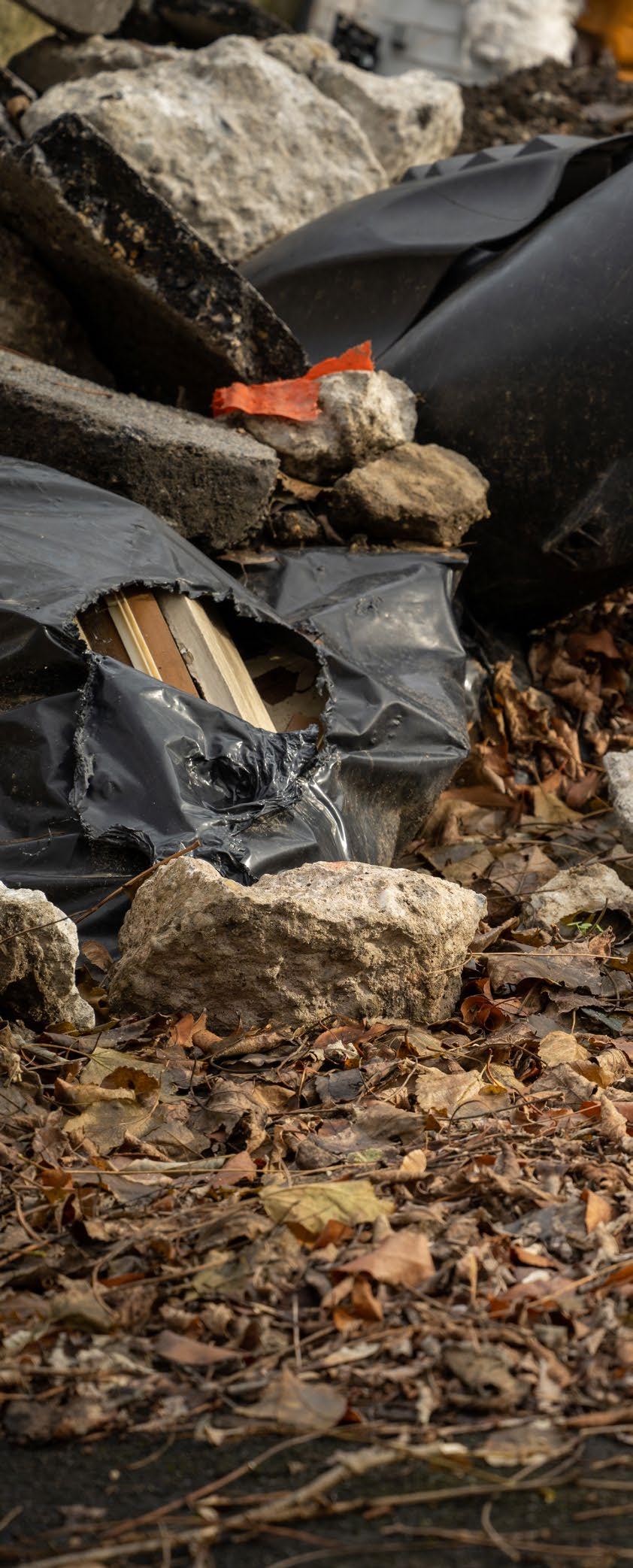
Illegal dumpers push their loads over the edge of the bridge over the railroad tracks on Whitby Avenue at 53rd Street in Southwest Philadelphia. On a visit in early December, what looked like the contents of a small apartment were scattered down the railroad embankment: a couple mattresses, halfopen suitcases full of clothing, a toy Captain America shield. On the sidewalk sat a broken bookshelf, large black plastic bags of foil pans and other cooking waste and one white plastic bag full of what appeared to simply be routine, household trash.
Derek Rigby, who lives around the corner from the bridge, takes part in cleanups with his neighbors and otherwise does his best to hound the City until they send a crew to clean it up. “We walk past the bridge to take the kids to school, to catch SEPTA, so we regularly will know whether it is clean or not and notice when the City responds to our 311 requests,” he says. If he and his partner keep submitting requests, it takes the City about a month to respond, he says.
“It makes me feel frustrated to see areas where I see lots of children walking to school treated as an area for dumping. And that the City doesn’t respond quickly,” Rigby says. “It also frustrates me that the City doesn’t have a better approach to trash removal and options for people to dump waste.”
The City’s sanitation convenience centers allow residents to dump extra household
waste (electronics, yard waste, furniture, etc.) but not construction waste. Commercial dumps charge $100 per ton but don’t offer rates for smaller quantities.
“Where I grew up in Utah you could pay five dollars to dump at the city’s municipal dump,” Rigby says. “As a Philadelphia resident who has done home renovations, the options I have found are the convenience sites, but they don’t receive construction materials. The other options are paying by the ton, which costs a minimum $100 dollars, which is not affordable to do regularly. I see that pattern as to why someone running a construction company or doing a project would choose to dump, because it is much cheaper to dump, and hopefully not get a fine.”
Providing disincentives to dumping, such as fines, will always be necessary, but reducing the barriers to legal waste disposal could also be part of the solution. Circular Philadelphia, a circular economy nonprofit organization founded by Esposito and Samantha Wittchen, has proposed a middle option, in collaboration with Trash Academy and Terrill Haigler (aka “Ya Fav Trashman”), in which the City’s sanitation convenience centers would accept a van or pickup truck load of construction waste for $30. Parks & Recreation’s Fairmount Park Organic Recycling center already offers a similar service for debris such as dead leaves or wood chips. “Even if the $30 fee doesn’t fully cover the total cost of disposal through the construction recycling contract, the difference will be far less than the amount of money the City spends cleaning up illegal dumping,” according to Circular’s policy brief on the proposal.
Lawson says he had some success with signage. Signs posted with an increased fee of $2,000 (up from $300) reduced dumping of commercial waste somewhat. “Seeing an extra zero deterred some people,” he says. “In other neighborhoods people spray painted the sign and kept on dumping, but putting the sign there says the City sees what you’re doing and doesn’t appreciate it.”
Stopping household waste dumping requires a different approach. “It is generally something people don’t consider to be wrong,” Lawson says. “There is a mentality of ‘the City should clean this up.’ If you’re a resident you might not be able to discern between Parks & Recreation and the Streets Department.”
Lawson had some success posting small signs right on the park trash cans, for exam-
24 GRIDPHILLY.COM JANUARY 2023
It should be no surprise that no one takes a job with the Parks Department to pick up people’s household trash or demolished apartments.”
— daniel lawson, former Parks & Recreation sustainability manager
ple in Marconi Plaza in South Philadelphia. The signs showed a cartoon figure warning against dumping. “When we put it on the cans, we mean you, standing there with your household trash in your hands,” he says.

Parks & Recreation also worked with the Streets Department’s SWEEP sanitation enforcement officers. “If we found a park getting chronically hit, we got a SWEEP officer to do targeted enforcement, see which addresses they came from and drop civil enforcement tickets in their mailbox.” The tickets are $50, not nearly as painful as the $2,000 dumping fine, but enough to get a household’s attention.
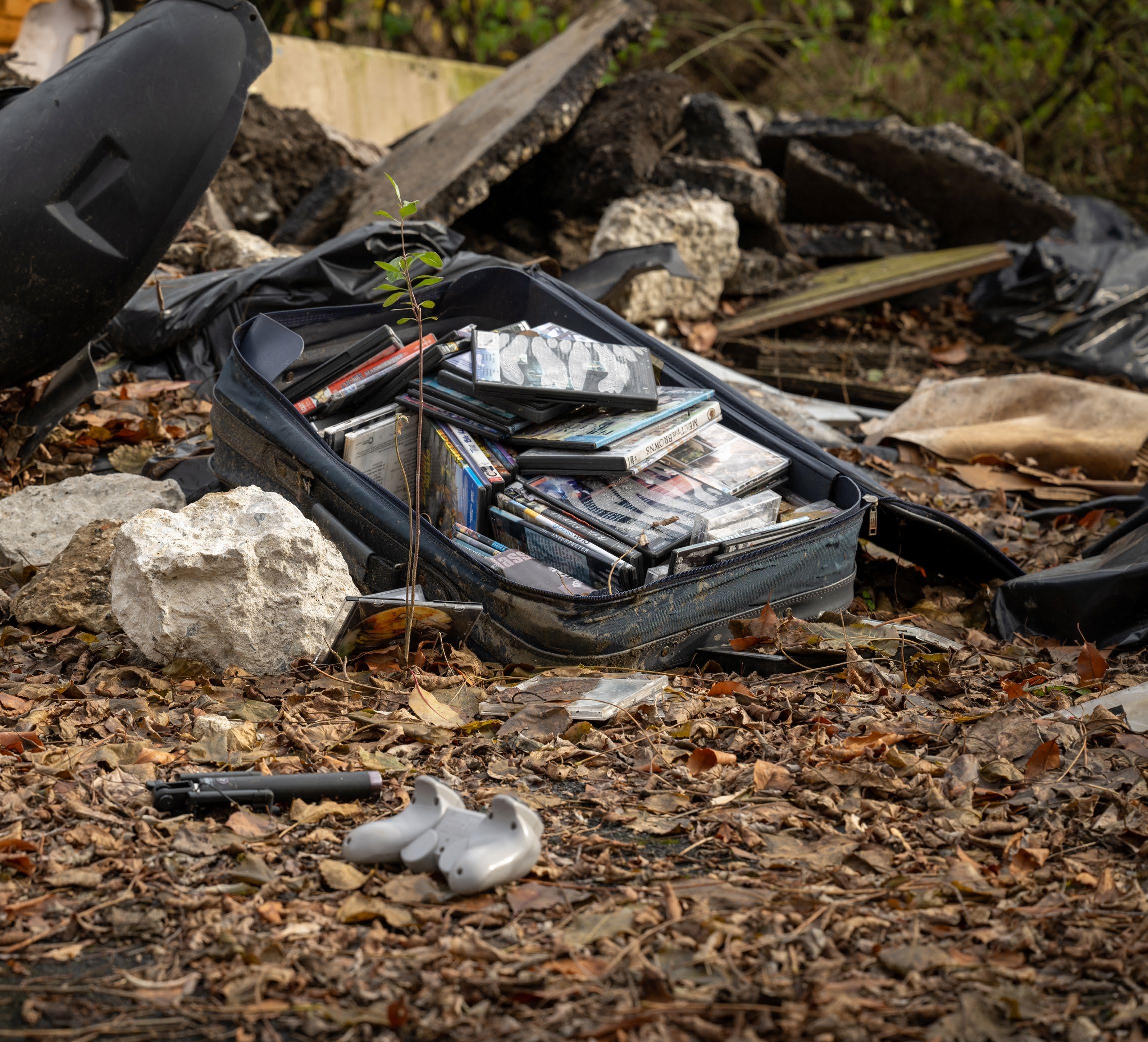
JANUARY 2023 GRIDPHILLY.COM 25
The City puts up signs warning of large fines, but they aren’t enough to deter illegal dumping, like this suitcase full of old DVDs.
Rousseau-Reed recently took part in Clean Philadelphia Now, an anti-dumping campaign of Mural Arts’ Trash Academy program. Along with other local antidumping activists they studied the causes of dumping and worked to produce a platform of solutions.
Along with continued abatement (cleaning up) of dumping and beefing up enforcement measures, such as by increasing L&I staffing, the draft platform that Grid reviewed in early December recommends allowing small-scale construction waste at convenience centers, in line with Circular’s policy proposal, as well as developing policies to require recycling construction debris.
People who dump waste tend to leave it in spaces that look to be abandoned, like the greenspaces of Eastwick, and the platform advocates beautifying these spaces and inviting the community to activate them by gardening or holding events. In a similar vein, Circular Philadelphia has launched an initiative to advise businesses on how they can utilize neighboring vacant lots
The platform recommends overhauling household waste collection by, among other measures, automating it. Providing households with standard lidded containers for household waste and recycling that can be tipped into trucks mechanically and, where appropriate, increasing collection to twice a week could give households less of a reason to ditch their trash in a park mid-week.
Good data on littering and dumping are key to developing and implementing solutions, and the platform endorses the restoration of ZWLC or a similar office.
Rousseau-Reed is clear that the work that Stewart, she and other local activists do to chase off dumpers and nag the City to clean
up is not a complete solution, but they aren’t waiting for citywide reform to save their neighborhoods from dumping.
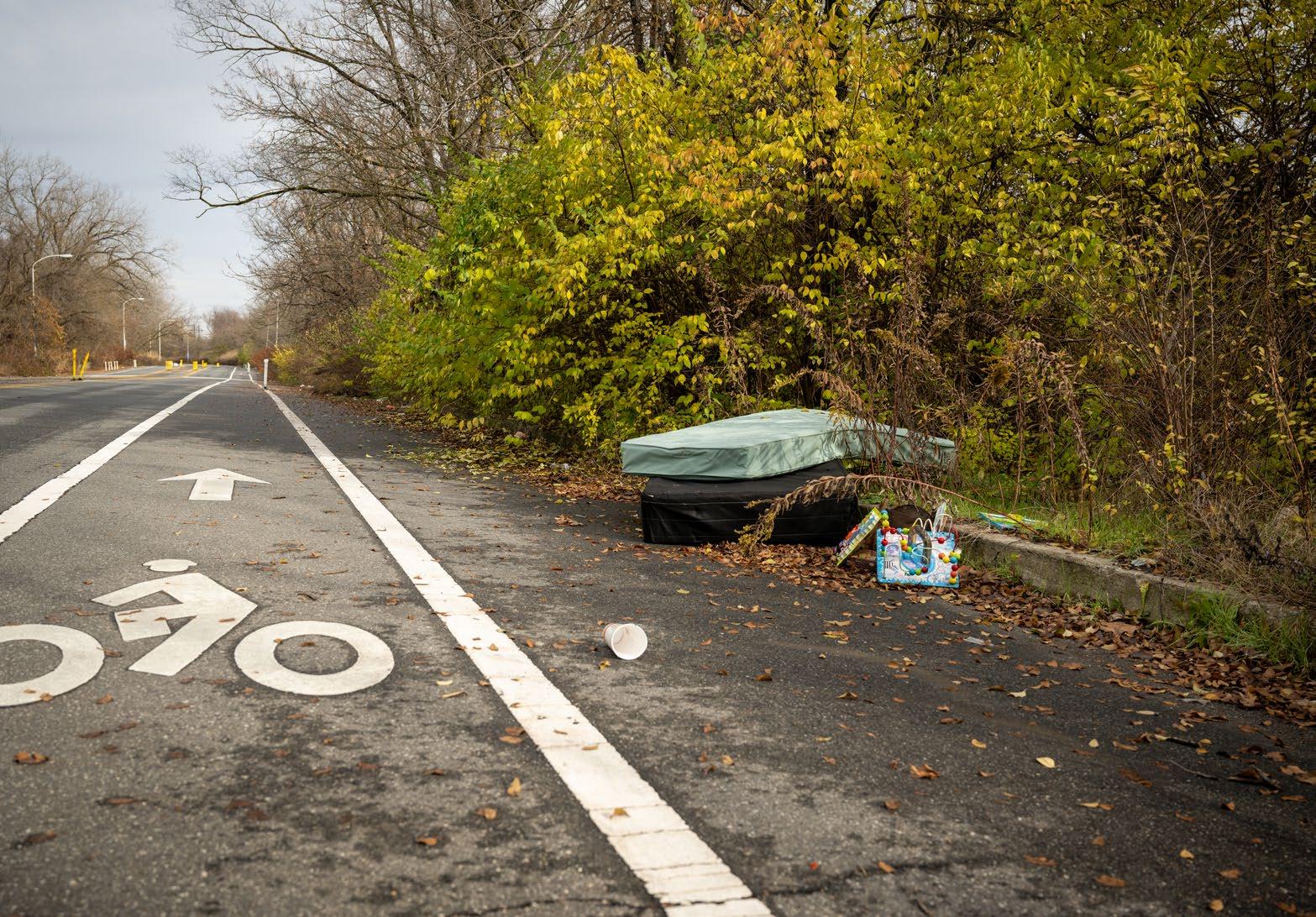

Along with other problems of neighborhood neglect, dumping eats away at the pride residents should feel in their homes. “Many neighbors have said to me, ‘I’m embarrassed when I have company,’” Rousseau-Reed says. Much of what the Eastwick activists do depends on restoring their neighbors’ sense of agency.
As the tour wound up, we encountered a
neighbor walking her dog on her way into the wildlife refuge. Rousseau-Reed talked with her for 20 minutes about how to organize her block, including an updated version of an old-fashioned phone tree. Whenever one neighbor spots something amiss, the entire block could be notified so that they could all call it in at once. She also talked up the recently launched neighborhood watch and the Eastwick bike patrol, all efforts by the community to take control of their streets. They could only do it together. ◆
26 GRIDPHILLY.COM JANUARY 2023
It makes me feel frustrated to see areas where I see lots of children walking to school treated as an area for dumping.”
derek rigby, Southwest Philadelphia resident
A bed frame and mattress lay on the side of Mario Lanza Boulevard in Eastwick.
Sustainably Easy
Goods — from soup to nuts to toilet paper — delivered without the waste
The rounds launched in Philadelphia in 2019 with a very simple mission — to make home delivery of what they call “the boring stuff” as sustainable and as effortless as possible.
“It’s hard to ask people, even those that are as sustainability minded as our members, to make big sacrifices in the name of sustainability,” The Rounds head of sustainable and service design Evan Abel acknowledges.
To create this ease, The Rounds offers residents in Philly, Miami, Atlanta and Washington, D.C. home deliveries of everyday products like hand soap, cleaning supplies and pantry items such as pasta and nuts in reusable containers. They also offer essentials such as toilet paper, and a growing selection of local food products.

Seeking out local brands not only spurs the city’s economy, but also gives The Rounds more control over bulk buying. In Philadelphia, The Rounds partners with Bean2Bean Coffee Co. to receive bulk coffee in reusable 50-gallon drums, which they use to fill reusable glass Mason jars, virtually eliminating all waste. The Rounds is looking to expand on these options as well as use their growing market influence to get even larger brands to reduce the packaging of the bulk items that are sent to The Rounds.
But Abel is just as excited about expanding sustainability initiatives within the company.
The first “boring” yet high impact sustainability initiative Abel points out is the switch from cloth tote bags to 100% post-consumer recycled plastic tote bags to deliver their products. While The Rounds had difficulty finding recyclers for the cotton tote bags when they reached their end of life, the manufacturer of their new plastic tote bags has committed to taking the bags back at the end of their life to recycle into new bags.
Abel also points out that, since these bags are easier to clean, they last longer and hold more material in a stabler way than the
— evan abel, The Rounds head of sustainable and service design
cotton bags, thus reducing how many bags they actually need to use.
This commitment to greater efficiency was also applied this year to improving their understanding of how their products move throughout the consumer chain and back into their inventory. This is what The Rounds calls “reverse logistics” and is aided by the use of QR codes on all of their containers.
These QR codes allow for The Rounds to know what containers each member has so they can better track their return rate. As this technology grows, The Rounds is also planning in 2023 to incorporate more gamification for members such as loyalty rewards programs where their customer service staff — dubbed “psychic home managers” — can better communicate with and incentivize members to make sure that containers are returned, helping The Rounds realize their
mission of 100% circular packaging.
And to get those products to your door, The Rounds has invested in a fleet of e-bikes in each city they serve. Not only do these e-bikes offer zero-emission transportation for delivery, they also reduce traffic congestion. The Rounds has determined that they can even more efficiently deliver to apartment complexes by using electric vans, which they are also investing in for 2023.
“The goal is sustainability, and when it aligns with economics, it’s a lot easier for us to make these initiatives a priority,” explains Abel. “We save money, members save money, and the planet saves these negative externalities of single-use waste. It’s great.” ◆
Looking to go zero-waste in the new year? Use code “GRID15” at therounds.co/GRID15 for 1 FREE month of membership AND a $15 credit to The Rounds.
JANUARY 2023 GRIDPHILLY.COM 27
THE ROUNDS
PHOTO COURTESY OF
The goal is sustainability, and when it aligns with economics, it’s a lot easier for us to make these initiatives a priority.”
sponsored content
HALF FULL?
by
Glass is 100% recyclable: it can be melted over and over again to form new glass products without any loss in quality. Most of it is not recycled, however, despite the fact that the planet is running out of the sand necesasary to make glass and other products. The opportunity for glass recycling, therefore, is enormous, but obstacles abound. Many experts believe that the pathway to saving glass from the landfill almost certainly begins with the dismantling of the singlestream system of recycling collection.
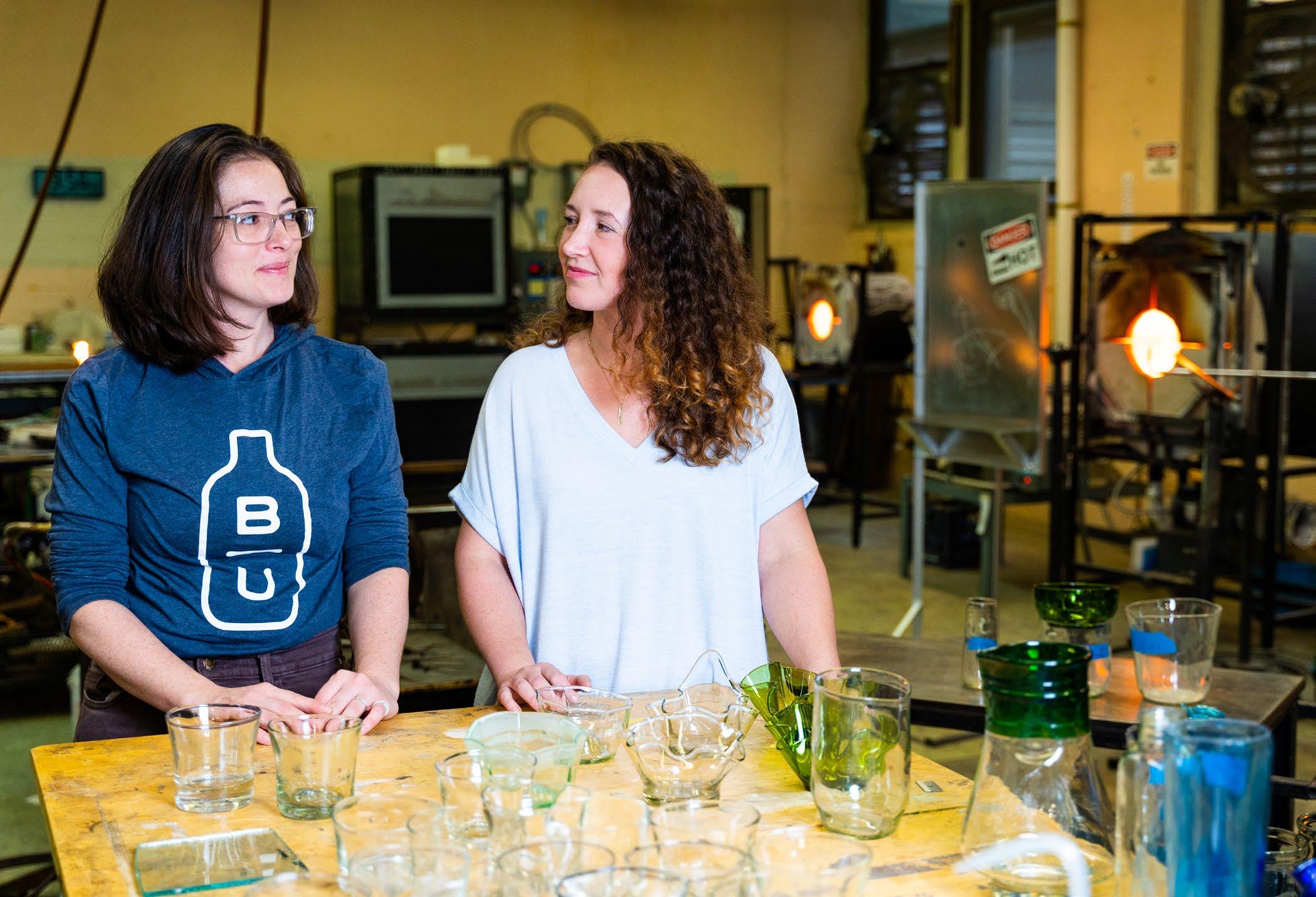
Maurice Sampson, the City’s first recy-
cling coordinator, proposed in the mid1980s a system based on the same conclusion. In his plan, every household would have two bins: one for paper and one for containers. The reasoning was that it would greatly reduce contamination, sorting would be easier and much more material would be recovered.
But the multi-stream system Sampson proposed required a new fleet of trucks, and the City did not want to invest the additional money. The existing side bucket trucks the City had at the time accommodated paper and combined glass and metal but could
not accommodate glass collected separately.
The system remained in place until 2008 when the City embraced single-stream recycling, the system we have now that collects all recyclables in the same blue bucket. Trucks with compactors, which were designed for garbage, were enlisted for the new task, with inefficient results.
“The whole thing has to do with what our priority is, and what the system of waste management is putting a priority on,” Sampson says. “If your emphasis in your system is waste disposal, then you undermine your recycling program.”
How glass recycling works
When Philadelphia residents put their blue bins out to the curb for recycling, the materials in the bin are taken to a materials recovery facility operated by Waste Management for sorting and preparation, to be sold to manufacturers who can use the material.
Very little glass actually makes it to an end market because the material is crushed, first by the truck’s compactor and then again when it reaches the Waste Management plant.
In theory, the cullet — smaller pieces of
28 GRIDPHILLY.COM JANUARY 2023
Local innovators divert glass from the landfill
lindsay hargrave photography by chris baker evens
Remark Glass and Bottle Underground cofounders Rebecca Davies (left) and Danielle Ruttenberg in their studio.
glass ideal for recycling into new glass objects — is supposed to fall through a grated floor to then be collected. It is usually impossible, however, to sort the glass by color and decontaminate it once it has been crushed and jumbled with microplastics and paper.
The problem
Much of the contaminated glass that is irreversibly mixed with other materials cannot be recycled; it can only be used as landfill cover. The City does not have numbers for how much glass in the single stream goes to the landfill. While landfill cover is technically a form of “downcycling,” along with other uses like sandblasting, the material is not making it to an end market to be given new life. It still sits in a landfill — the opposite of the aim of recycling.
The Streets Department says that glass makes up about 18% of recycling materials. In 2017, that number was 28%.
Keeping glass out of the landfill
AeroAggregates, a company producing lightweight foam glass, has found a way to keep glass out of the landfill.
Aero uses the small, mixed-color pieces that are unusable and unrecyclable in any other context to make foam glass, which is used in construction of roads and buildings. Their secret to using this otherwise landfill-bound material? Small particle size and specialized cleaning equipment.
“One of the things we did early at Aero was invest in our own cleaning equipment so that we could take some of that glass that nobody wants, and that’s kind of been one of the keys to our business. The glass we use is literally the stuff that nobody else could use,” says Archie Filshill, founder and CEO of AeroAggregates. And for that reason, he says, Aero’s “finished product is basically 100% curbside post-consumer glass.”
The Eddystone, Delware County-based company works with Philadelphia as well as Delaware, Lehigh, Montgomery, Camden and Burlington counties.
Diverting the waste for reuse
Offering on-demand and subscriptionbased service models for both homes and businesses, Rabbit Recycling accepts everything the City does plus additional materials that are more difficult to recycle: batteries, straws, light bulbs, rubber bands and hundreds more items. Unfortunately, one of the
few things they cannot accept for safety reasons is broken glass — and that’s because everything they collect is sorted by hand.
“We don’t dump anyone’s stuff together. So if you give us your stuff and it’s clean and dry — which is what we require — then it will be recycled,” says Rabbit Recycling project manager Zoe Fuhrman. “Even if somebody else didn’t clean their stuff, it won’t contaminate yours.”
Rabbit sorts glass by color and texture
and anyone — artists, educators, glassblowers — can source glass from Rabbit for free. Their only requirement? Make sure the glass gets reused.
Rabbit Recycling’s glass strategy promotes reuse. Instead of grinding bottles up to be recycled, less energy and transportation is involved in keeping whole bottles in the local economy.
“Our goal is to keep all waste as local as possible for reuse or recycling,” Fuhrman says.
Reusing bottles, recycling glass

One of the major recipients of whole bottles from Rabbit Recycling is Bottle Underground, the nonprofit glass reuse and recycling arm of Remark Glass.
Remark was founded in 2016 as a small batch studio using 100% post-consumer glass. Remark worked closely with their clients and community to source glass. “We were interested in what the glass was
JANUARY 2023 GRIDPHILLY.COM 29
Remark Glass can upcycle bottles into everything from light fixtures to tableware.
It is going to take a lot of resources to change the flow of material here.”
— rebecca davies, co-owner of Remark Glass and cofounder of Bottle Underground
capable of in the glass studio,” says Remark cofounder Rebecca Davies, also a founding board member of Bottle Underground.
In 2020, recognizing a need for scalable recycling efforts, Remark launched its sister nonprofit, Bottle Underground, which focuses on taking glass donations, finding the best use for materials and creating processed glass for multiple end markets, from their own glassblowing studio to local businesses that need, say, whole reused jars.
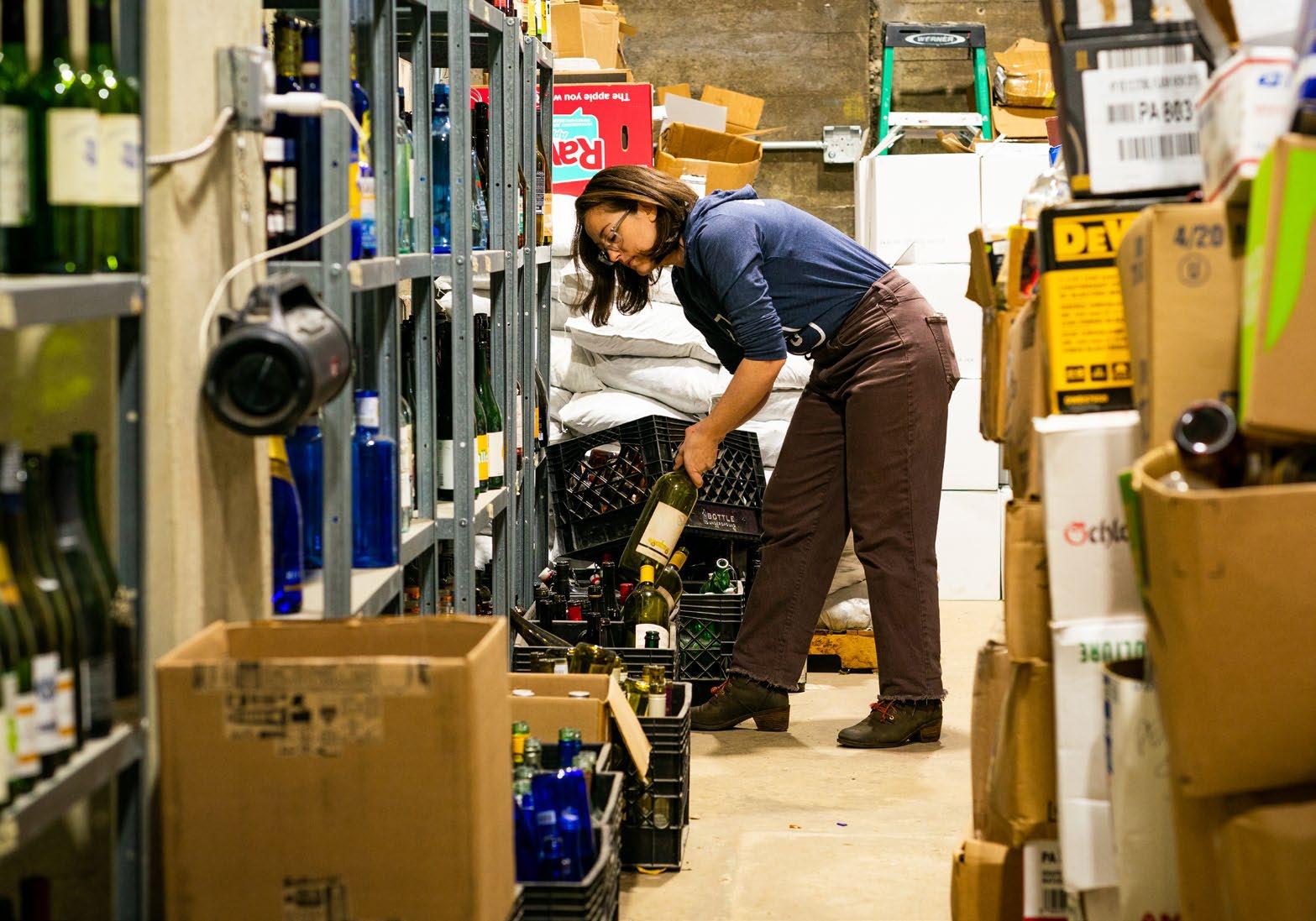
And while Remark blows its own glass items from recycled materials, Bottle Underground is focused on collecting whole bottles and jars, which are then cleaned and made ready to use for interested businesses. Some of these businesses include Saté Kampar, South Philly Food Co-Op and Vellum Street Soap Company. According to Remark’s website, this has kept 153,631 pounds of glass out of the recycling process altogether, saving energy and emissions.
“There was a huge demand for people who wanted to participate,” Davies says of the expansion. And it fits with the Remark founders’ own “true desire to participate” beyond collecting glass for use in their studio.
The future of glass
While it seems inevitable that, eventually, markets will open up for glass recycling to be profitable, it doesn’t seem imminent. “It is going to take a lot of resources to change the flow of material here,” Davies says.
In the meantime, attacking the problem from as many angles as possible is key,

Davies believes.
“It would be great if we could have one solution that we could kind of apply and see huge changes,” she says. “I think that what is important about waste and material is that it won’t really look like a one-size-fitsall solution, not even for all the glass here in Philadelphia.” ◆
30 GRIDPHILLY.COM JANUARY 2023
Remark Glass stores boxes of glass they collect from the community in the basement of the BOK building.
TOP OF MIND
COMPOSTING
Back to Earth Compost Crew
Residential curbside compost pick-up, commercial pick-up, five collection sites & compost education workshops. Montgomery County & parts of Chester County. First month free trial. backtoearthcompost.com
COMPOSTING
Mother Compost
Woman-owned composting company providing service to the Main Line & educational programs for those looking to compost at home. Interested? Find out more at mothercompost.com
CAFE
The Random Tea Room

A woman owned co-working cafe that seeks sustainability in every cup. Our tea and herbal products are available prepared hot or iced, loose leaf & wholesale for cafes and markets. therandomtearoom.com
GROCERY
Kimberton Whole Foods
A family-owned and operated natural grocery store with six locations in Southeastern PA, selling local, organic and sustainably-grown food for over thirty years. kimbertonwholefoods.com
local businesses ready to serve

WELLNESS
Root & Branch Bodywork
Sports massage & therapeutic bodywork to enhance performance, optimize recovery and keep you moving! Only natural, nontoxic, hypoallergenic products are used. Book online at rootandbranchbodywork.com
BIKE SHOP Trophy Bikes PHL
In Center City! Since 2003, Selling + Servicing BROMPTON FOLDERS, and now the new Brompton ELECTRIC. *ALSO: The BEST selection of BICYCLE BELLS on the East Coast. @trophybikes
WELLNESS
Acupuncture In Motion
Evidence-based holistic medicine to help you rebalance and thrive! In-person and telehealth services, and a full service Chinese herbal medicine dispensary. Book online at acupunctureinmotion.com
BOOK STORE
Books & Stuff
ENCOURAGING … Literacy, Knowledge, Creativity and Inquisitivity! at booksandstuff.info


Bennett Compost will pick your tree up curbside on one of three upcoming weekends and take a portion of them to the South Philly Tree-Cyclers for you. Trees that can’t go to the Tree-Cyclers will be chipped at our site and used in our composting process.
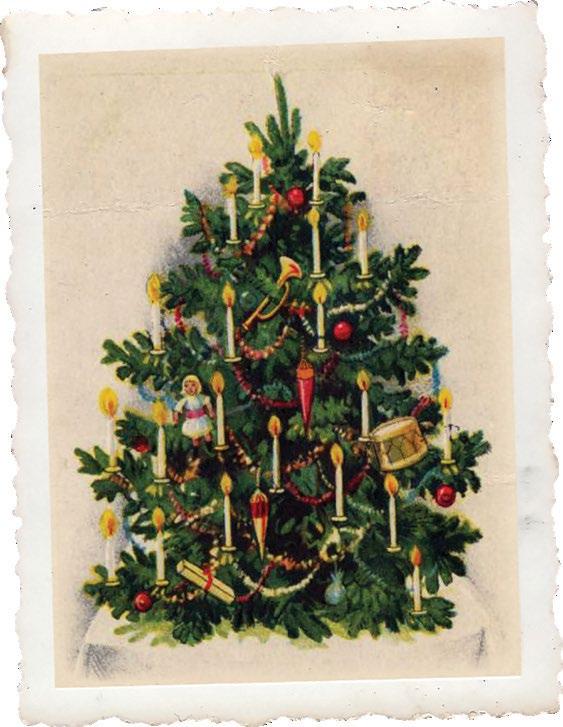

December 31, January 7-8, January 14-15 | $20
Bennett Compost www.bennettcompost.com 215-520-2406

JANUARY 2023 GRIDPHILLY.COM 31
sure what to
your
CHRISTMAS TREE ? Not
do with
Waste Watchers
We can help to curb household food waste as individuals
we’ve all been there — food in our fridge or on our counter, perfectly good, but with a rapidly narrowing window in which it remains edible. Add to that a trip out of town, and you’ve got a recipe for moldy, rotten items that can stink up your entire kitchen by the time you return. Into the trash goes a full carton of decaying strawberries.
Food waste is a huge problem for our country. In an average year, we throw away 108 billion pounds of food, amounting to 130 billion potential meals. Nearly 40% of this waste comes from our homes, a statistic that we can all endeavor to decrease. So, as individuals, what are our options for re-homing our almost-overripe strawberries?
This whole pint of strawberries will rot while you’re on vacation if left in the fridge.
You could eat them all, but that probably isn’t the smartest idea. That’s a lot of fruit.
You can rest easy knowing that your strawberries were put to good use in a tasty daiquiri.
You could throw out your strawberries, but that’s not really in keeping with the spirit of this infographic.
A great option for local food rescue are community fridges. These resources became more prominent during the pandemic and remain a great solution.
Better than tossing your fruit in the trash is adding it to your compost. Much better solutions exist, however!
Apps out there like Food Connect allow individuals to donate surplus food, and they will pick it up!
Another option is to see if any local friends could use your surplus food and deliver it by foot or by bike.
At the largest scale, food producers and distributors can repurpose large quantities of surplus food through hunger relief organizations like Philabundance or SHARE.
CABBAGE, INC
An organization like Philly Food Rescue provides a solution for ServSafe restaurants and grocery stores to repurpose their surplus food.
NURSING CENTER
Food Rescue Co.
FooD Connect
written and illustrated by bryan satalino, assistance by philly food rescue
32 GRIDPHILLY.COM JANUARY 2023
Friends of Heinz Refuge (FOHR) works in partnership with John Heinz National Wildlife Refuge to connect people with nature and promote a culture of environmental stewardship through education, outreach, service and nature-based recreation for the conservation of wildlife and habitat.


We envision a society that understands, appreciates, and takes responsibility for the natural world. We foresee significant and meaningful preservation of the natural world for current and future generations of people and wildlife.
TO LEARN MORE PLEASE VISIT fohrefuge.org • @friendsofheinz

Stitching together an ideal curriculum
As an undergraduate, Ria Sheth (MES ’20) studied structural engineering and ran a small business designing custom sleepwear called Majama Pajama. When she took a final elective course in green buildings, she was inspired. “It was the first time I realized I could take my career down an environmental path,” she says. She looked for a master’s degree that would support her interests in sustainability and chose Penn’s Master of Environmental Studies (MES) program.


“I picked the Penn MES because the coursework was interdisciplinary and because I could learn about sustainability at various scales,” she says, but she struggled with the theoretical coursework in her first semester. “I wanted something that was a little more practical because I am an engineer.” Ria took her concerns to the program director, Dr. Yvette Bordeaux, who recommended the individualized concentration. “I was encouraged to follow my interest in sustainable design and take classes that were more technical and design focused.”
Virtual Café
Join the MES program team from 12-1 p.m. on the first Tuesday of every month for an online chat about your interests and goals. Log in with us.
The courses she chose for her concentration—including classes in carbon analysis, life cycle assessment, and city planning—would be some of the most relevant for her career. Today Ria is a sustainability designer at Atelier Ten in New York, where she researches, assesses, and certifies green building projects. She also continues to run Majama Pajama and plans to make it more sustainable. “Penn has been the best experience I’ve had so far,” she says. “I’m really happy that I’m actually doing what I’m passionate about.”
To learn more about Ria’s experience at Penn and beyond, visit: www.upenn.edu/grid
www.facebook.com/UPennEES @Penn_MES_MSAG
Ria Sheth, MES ‘20 Sustainability Designer, Atelier Ten







































































